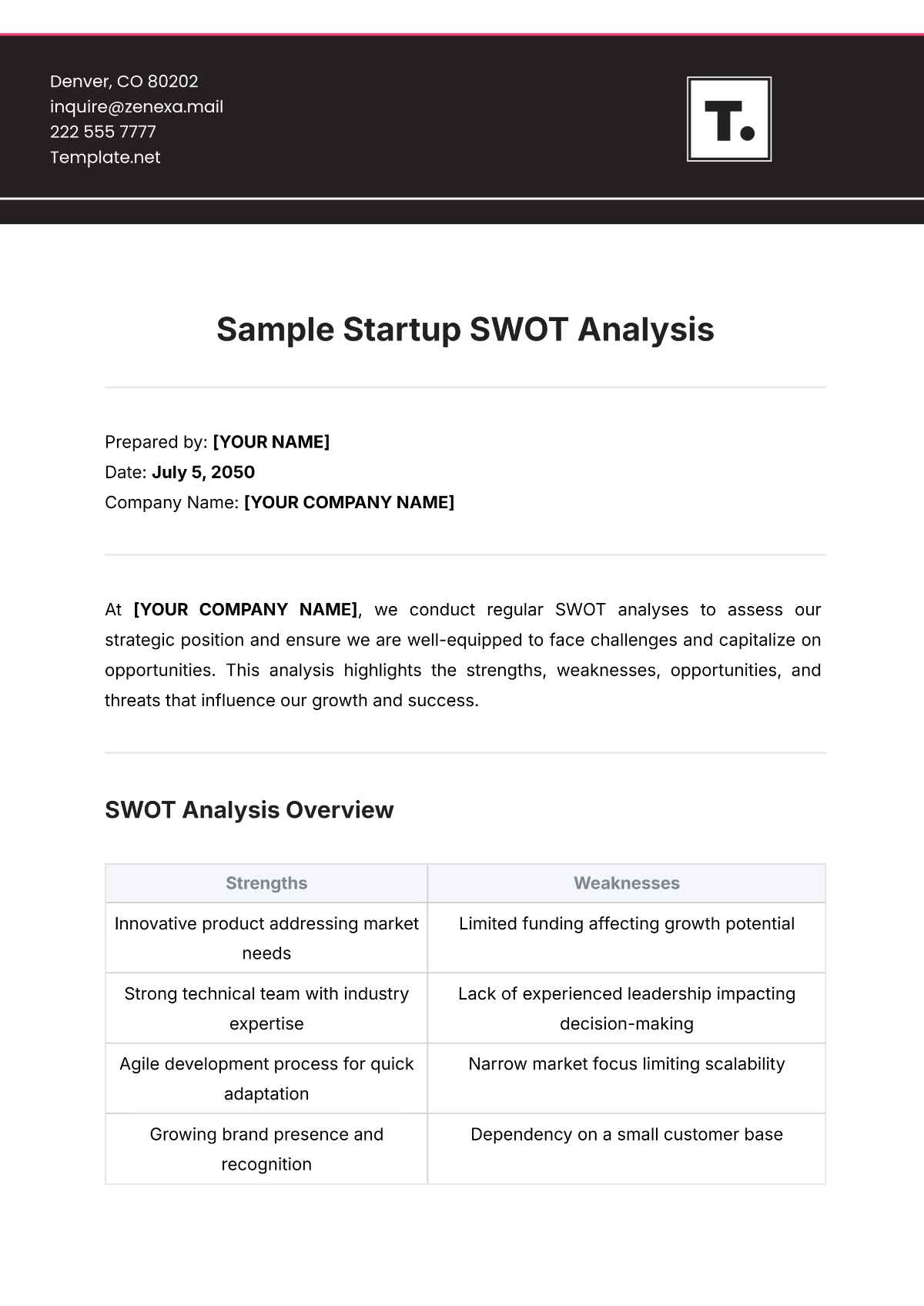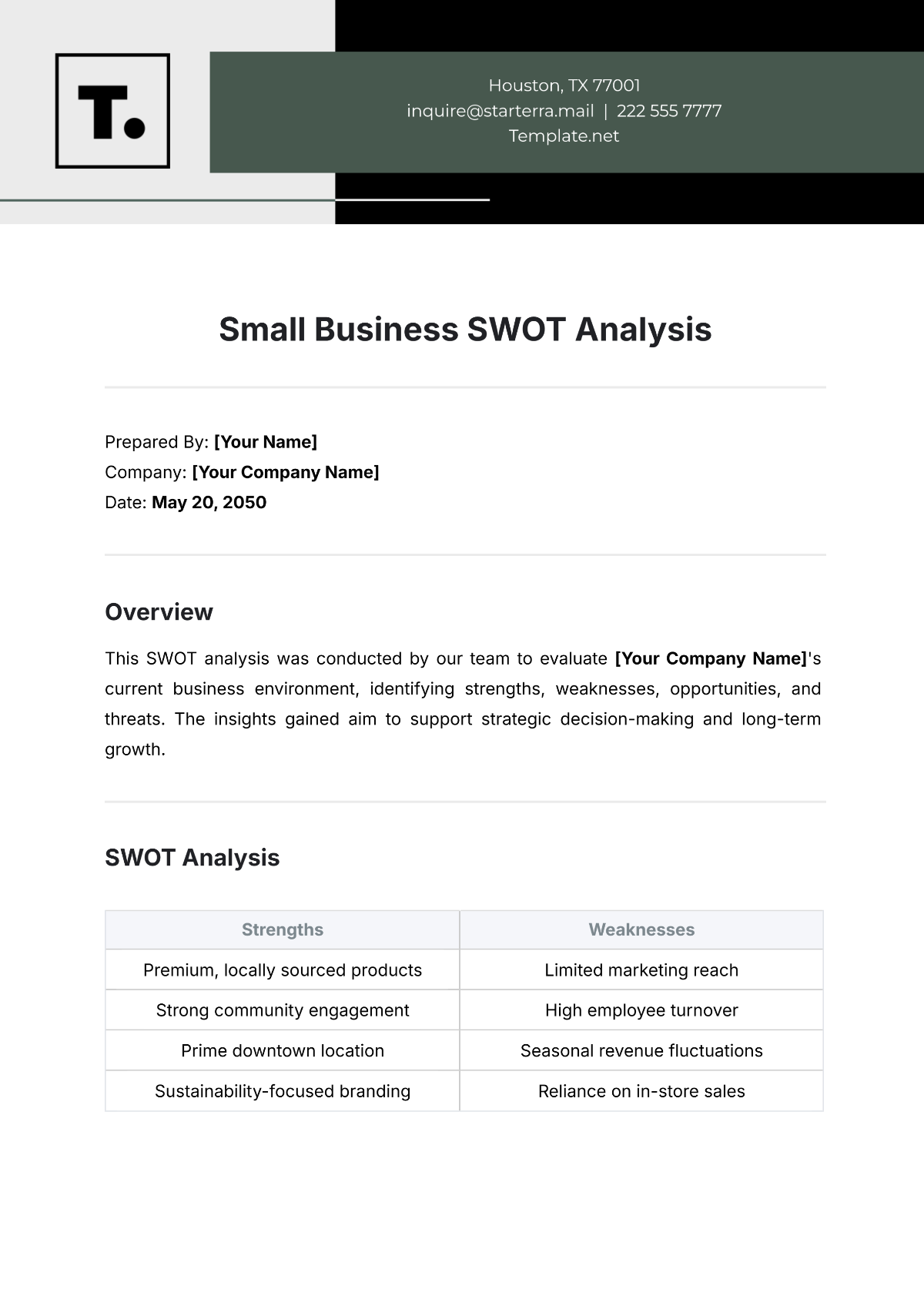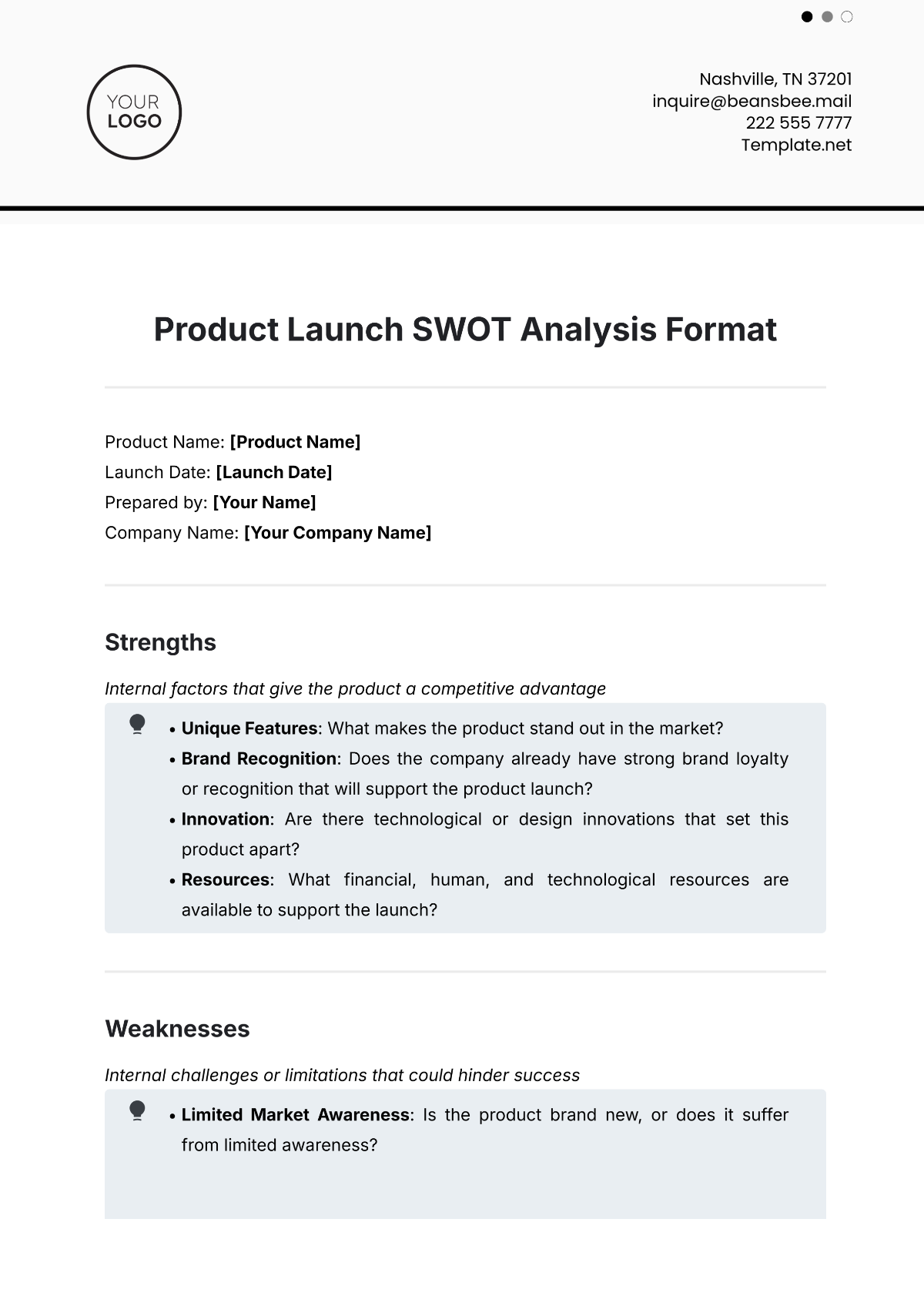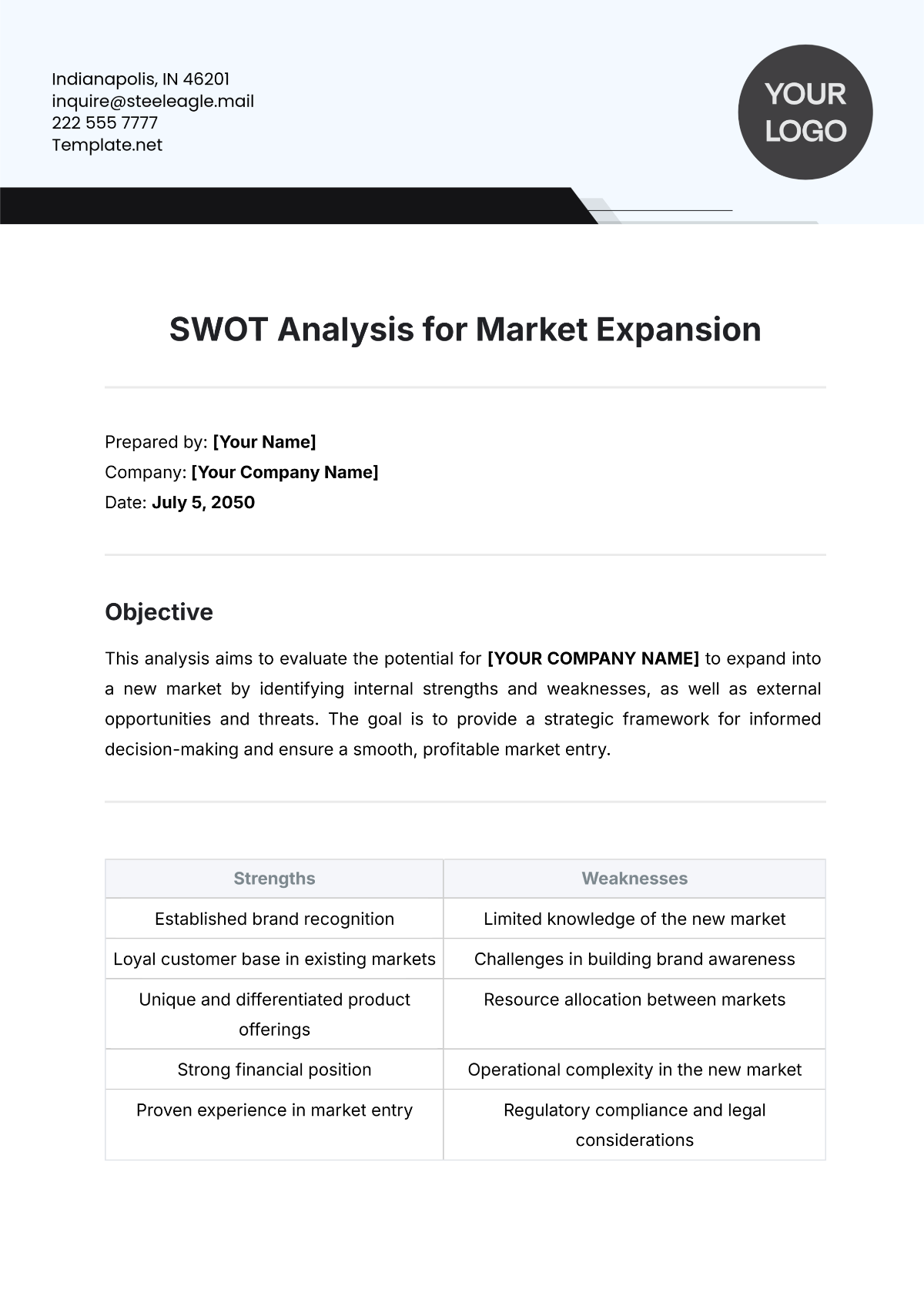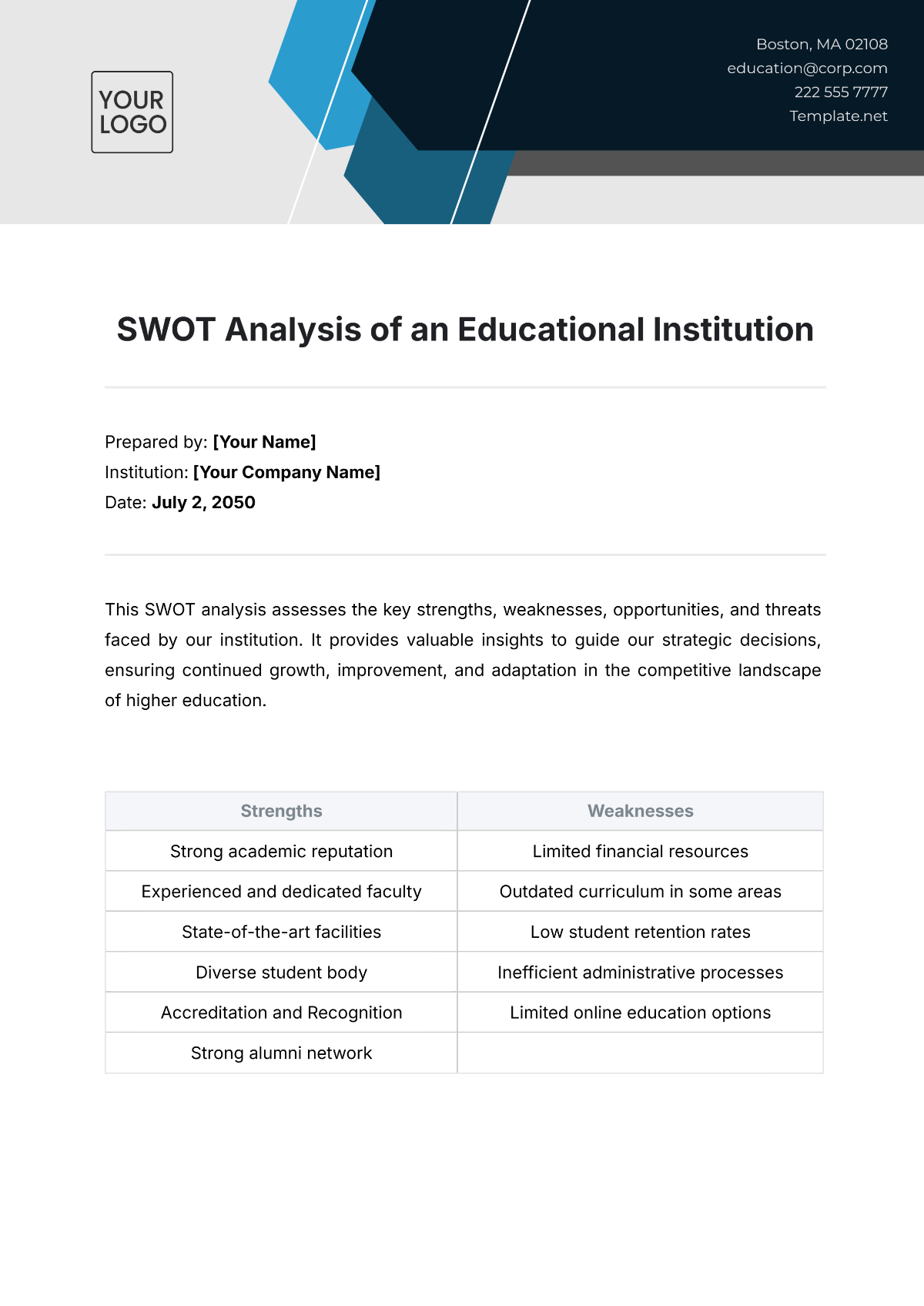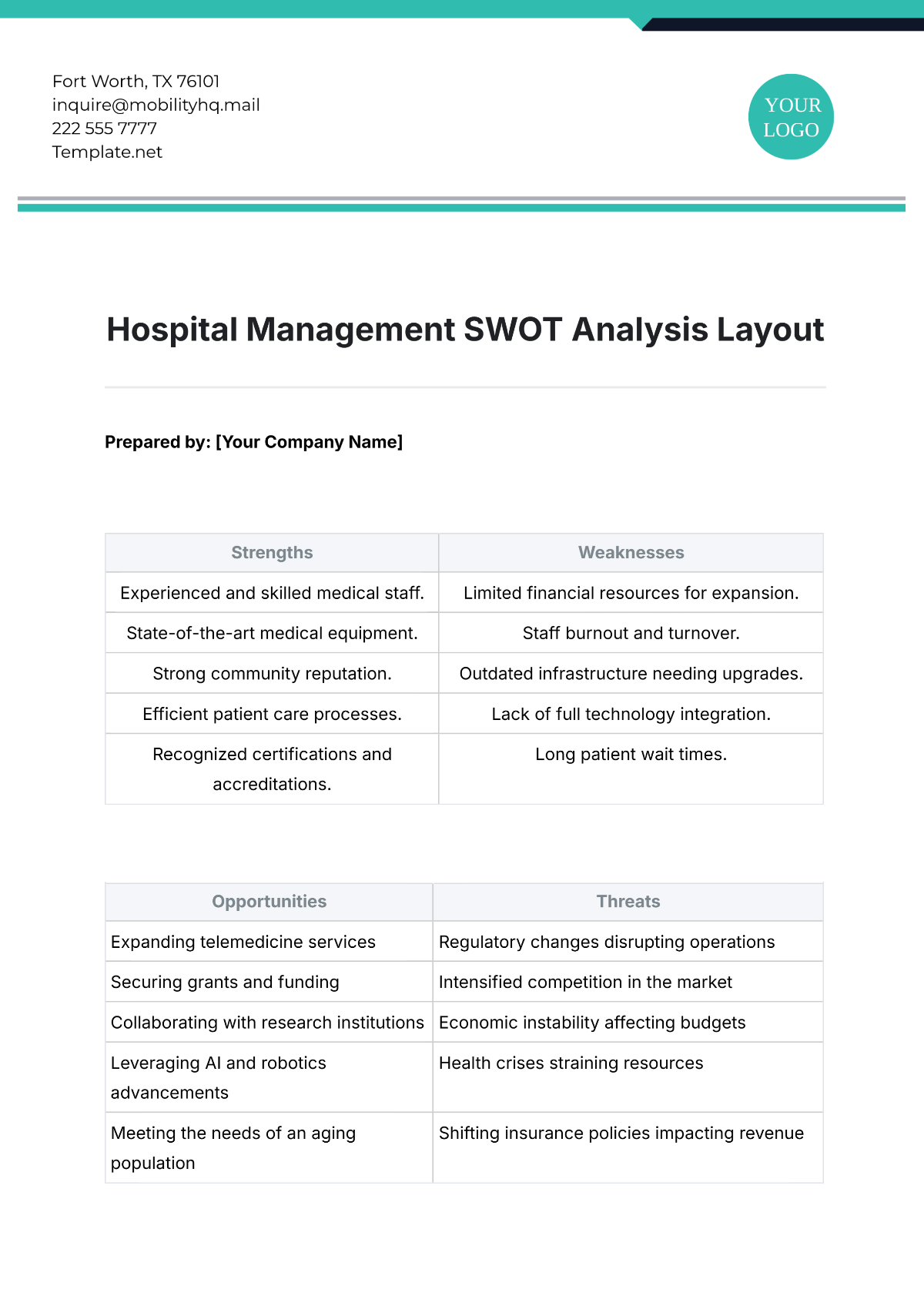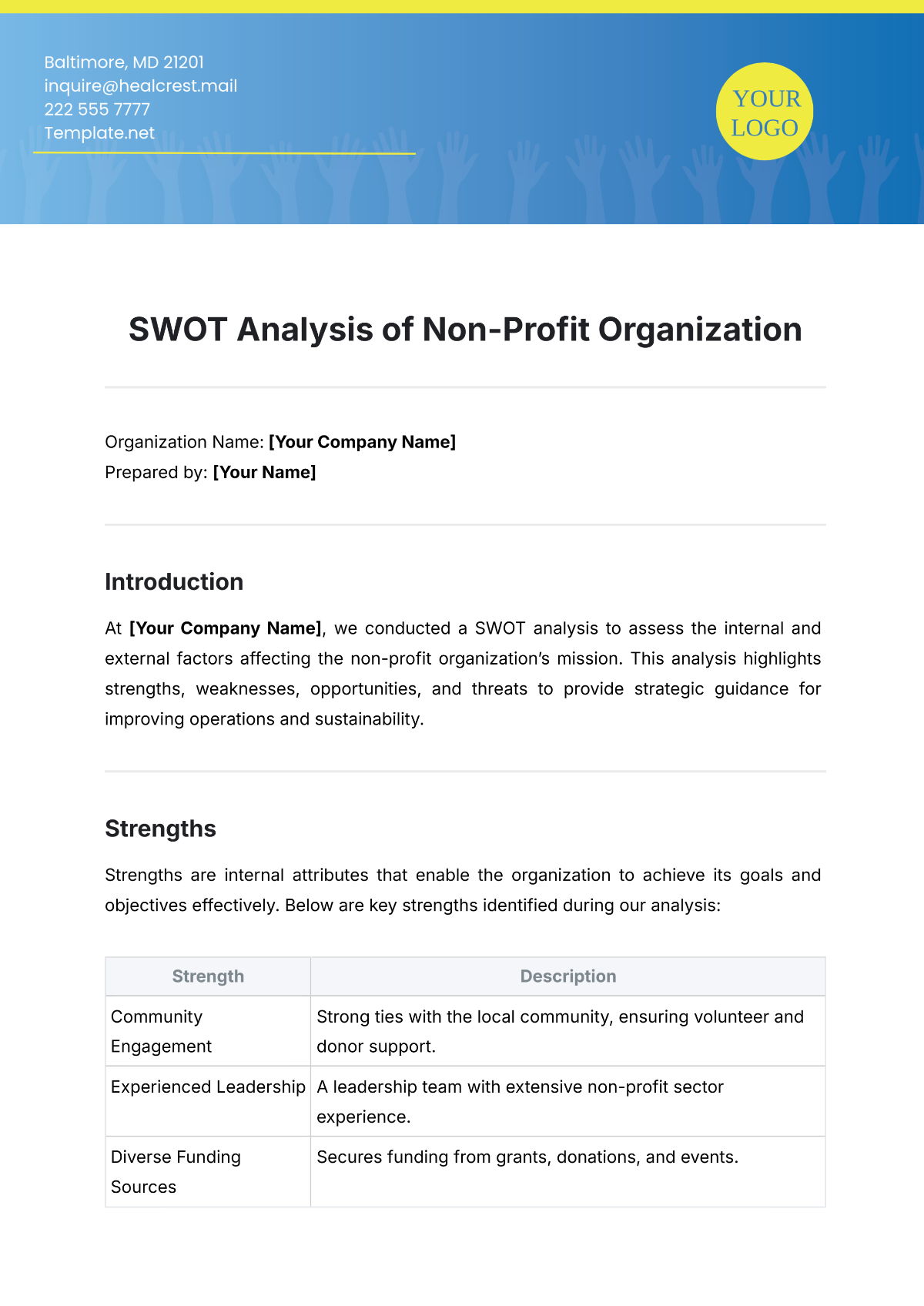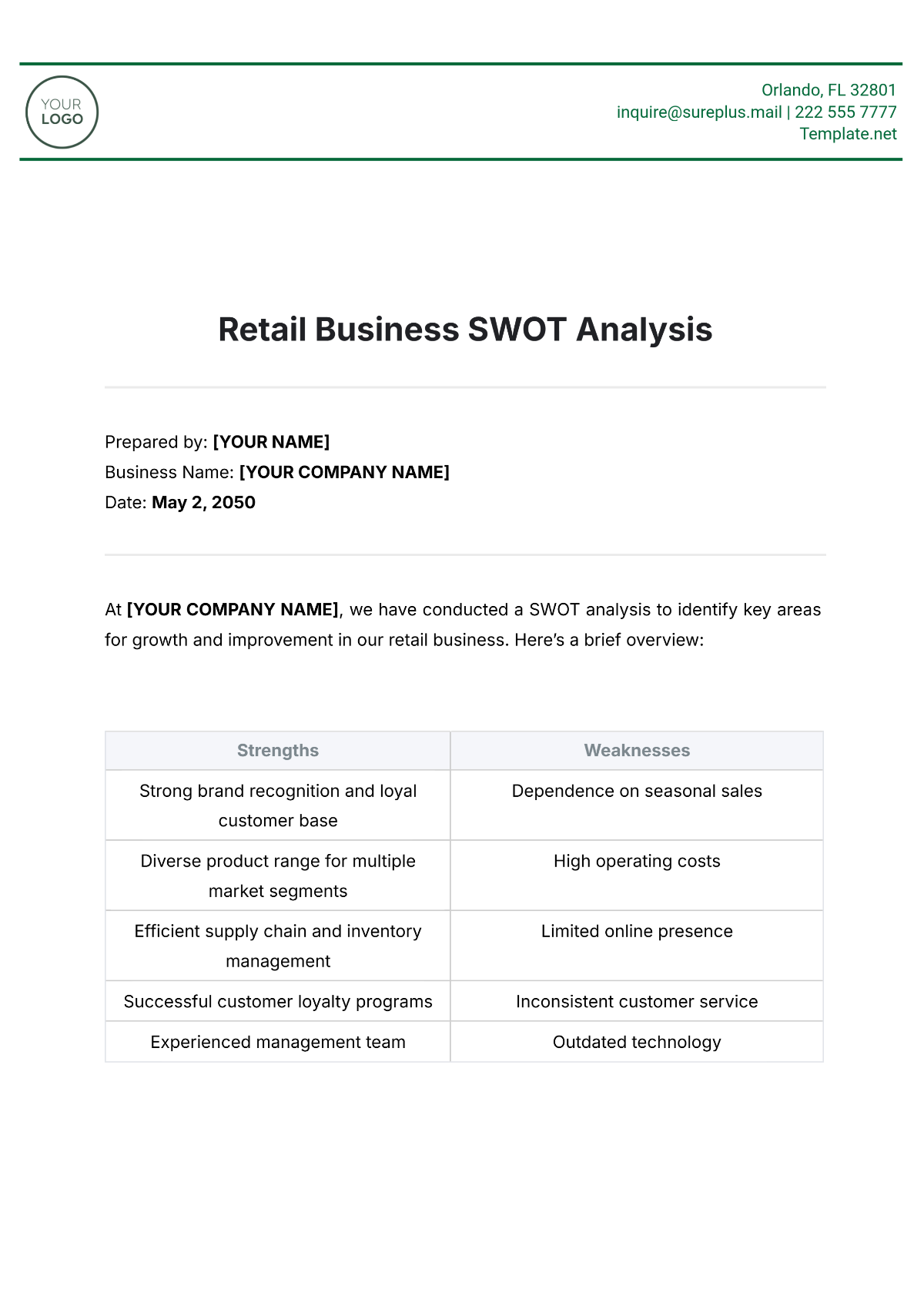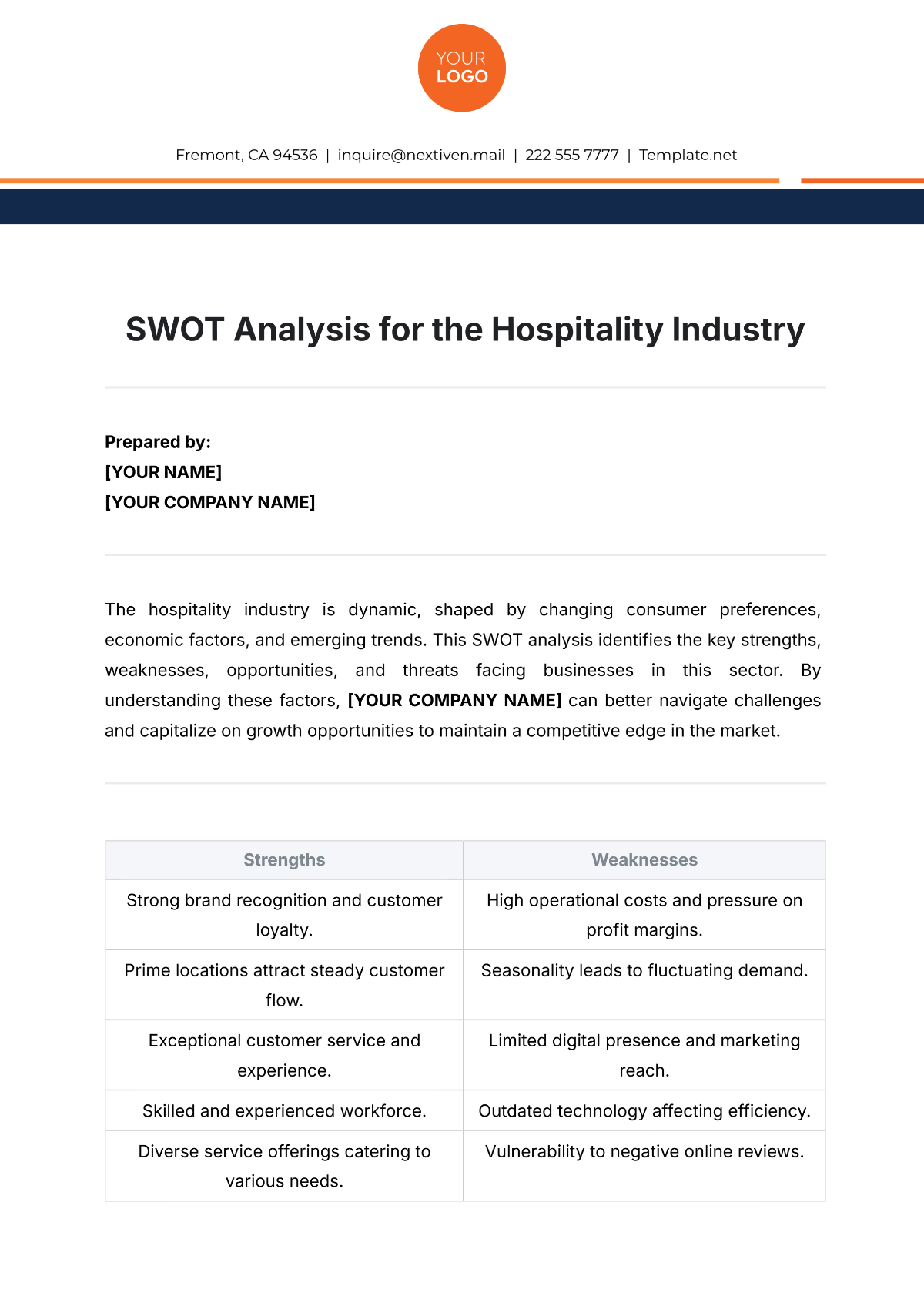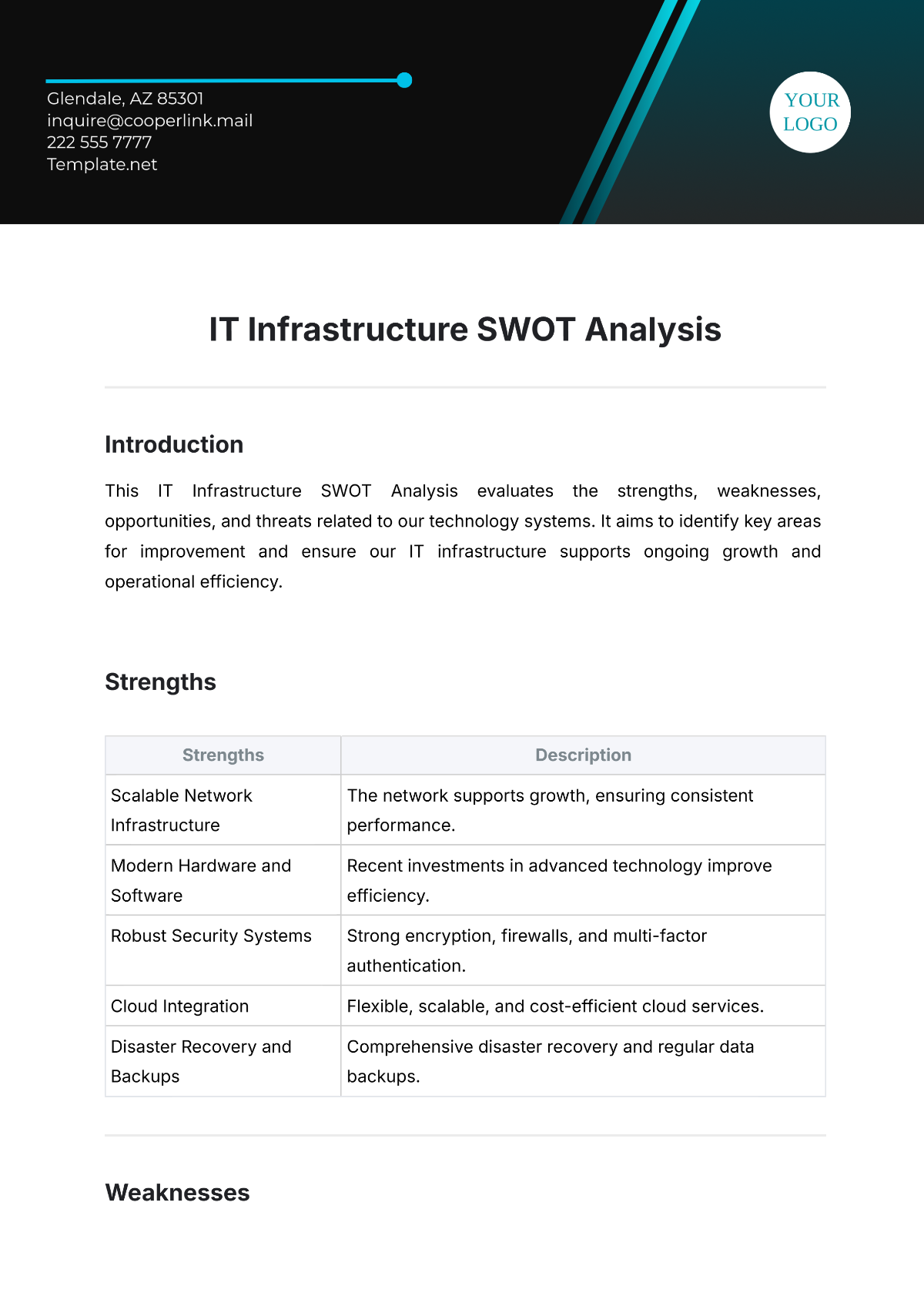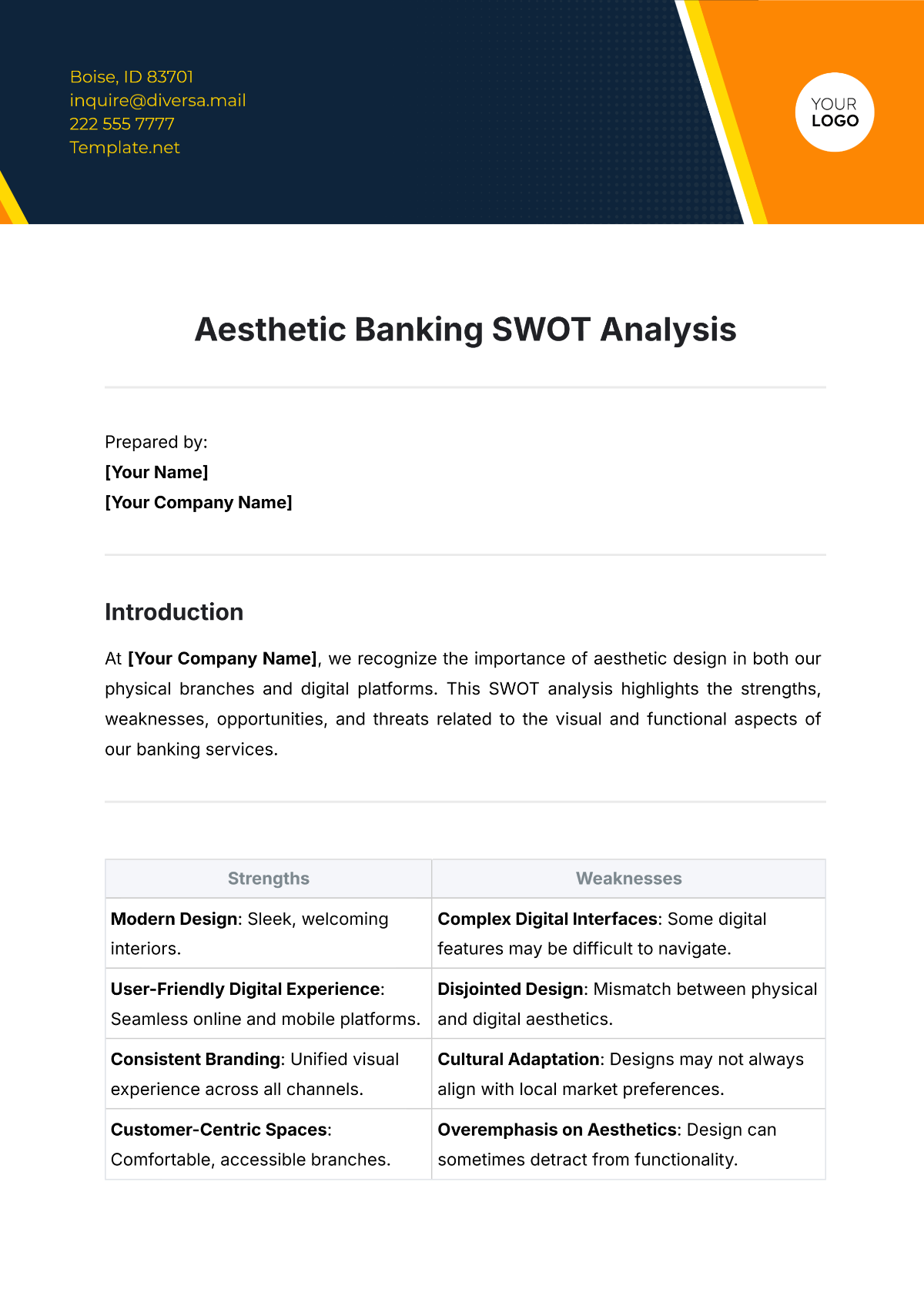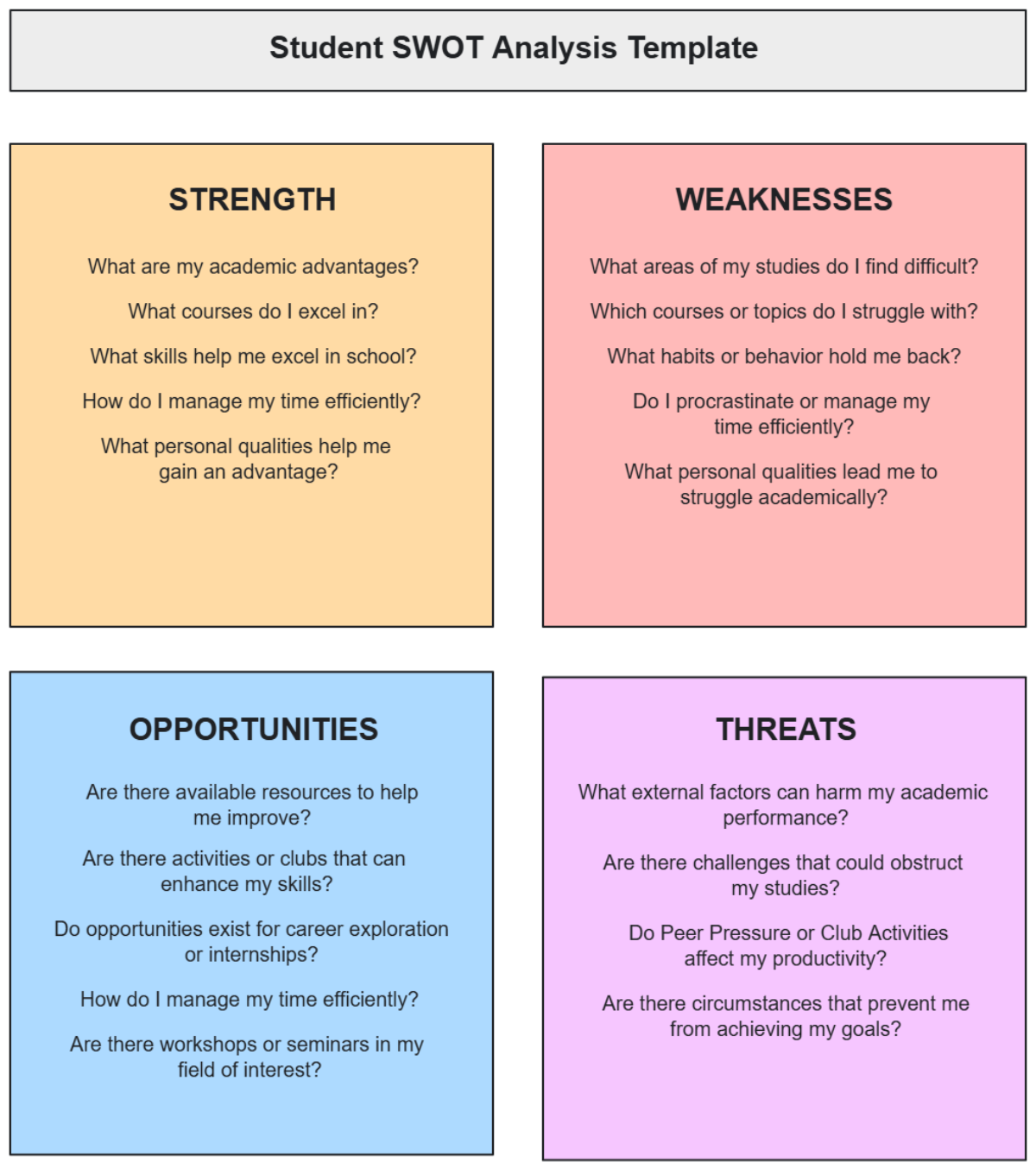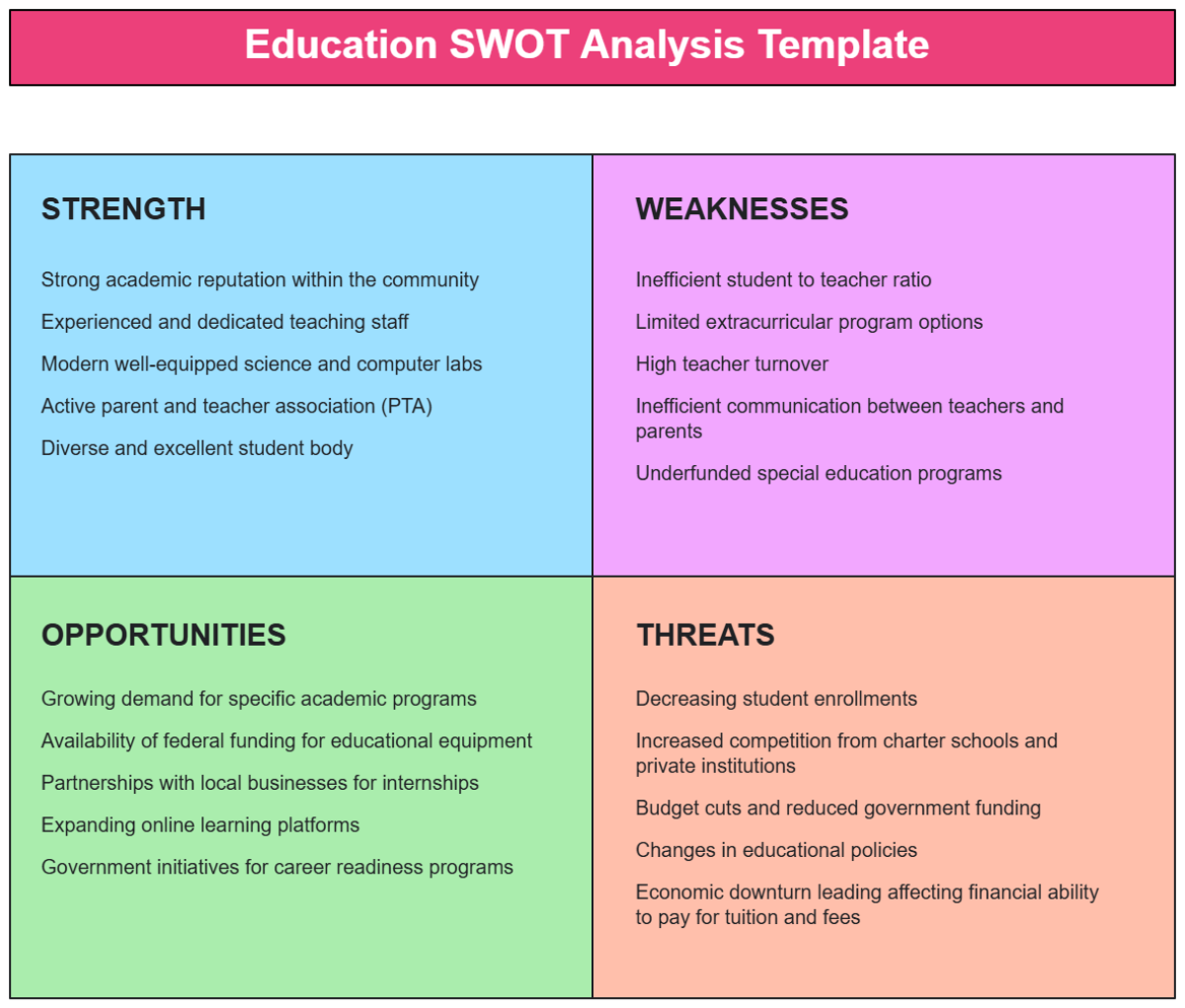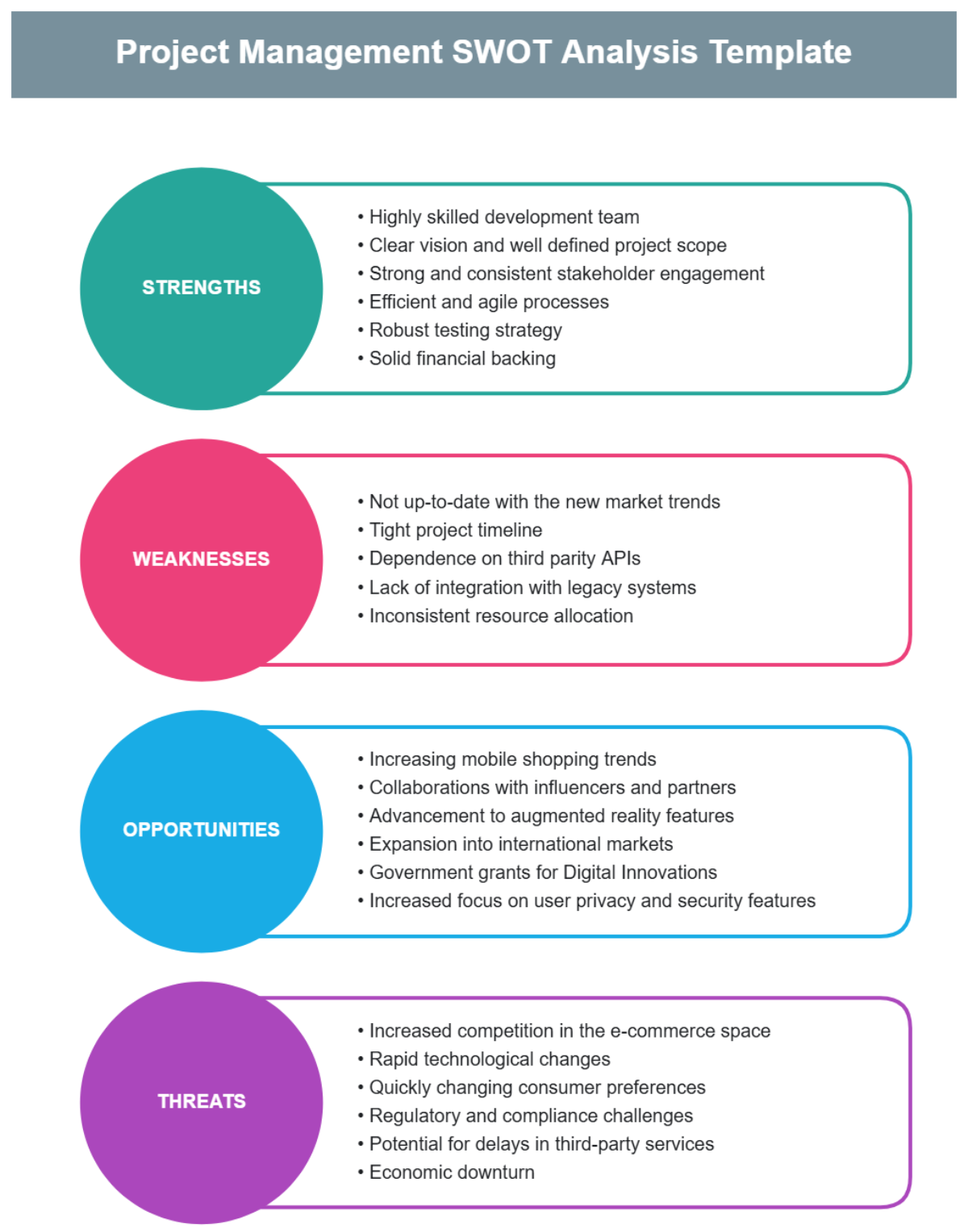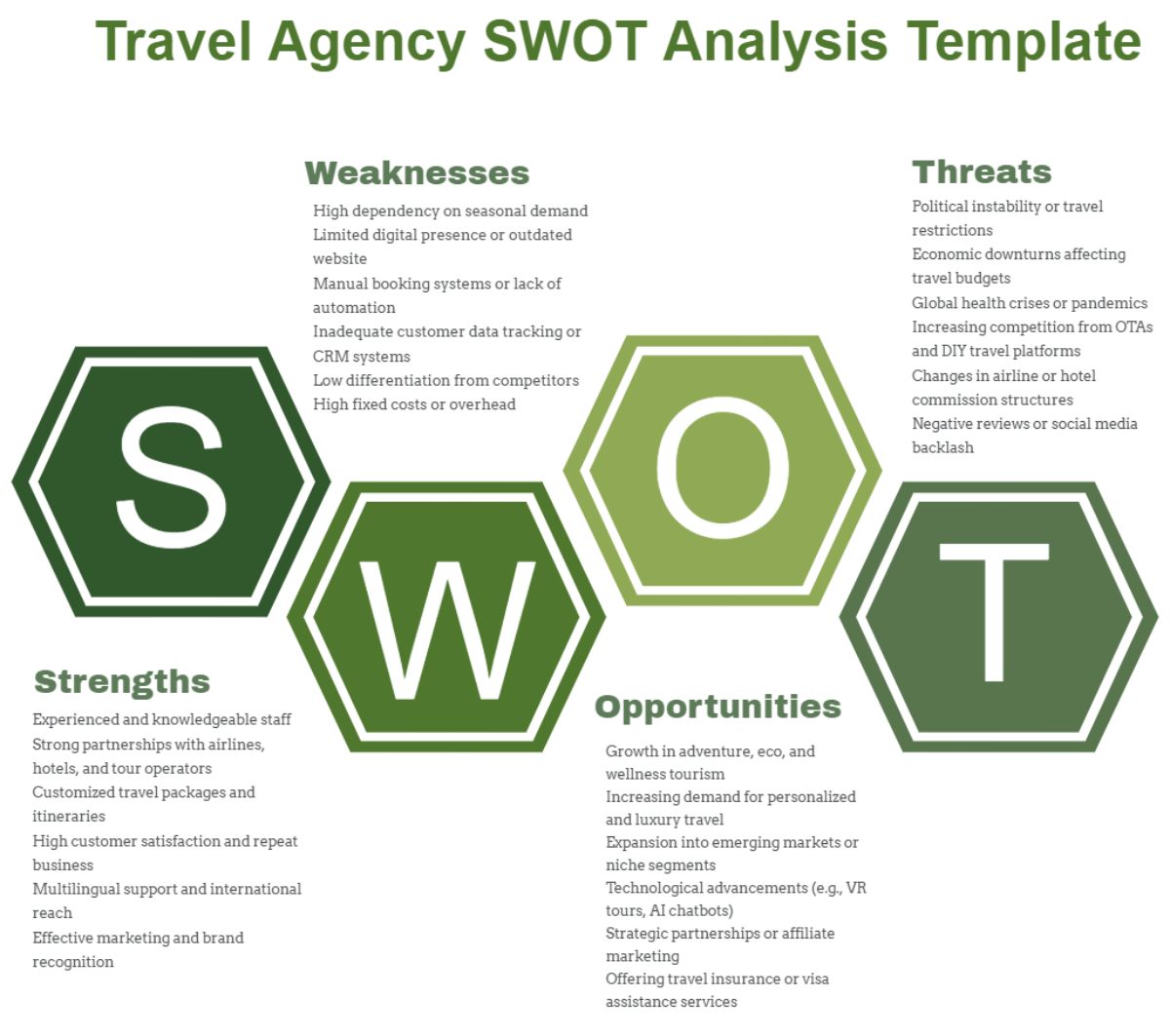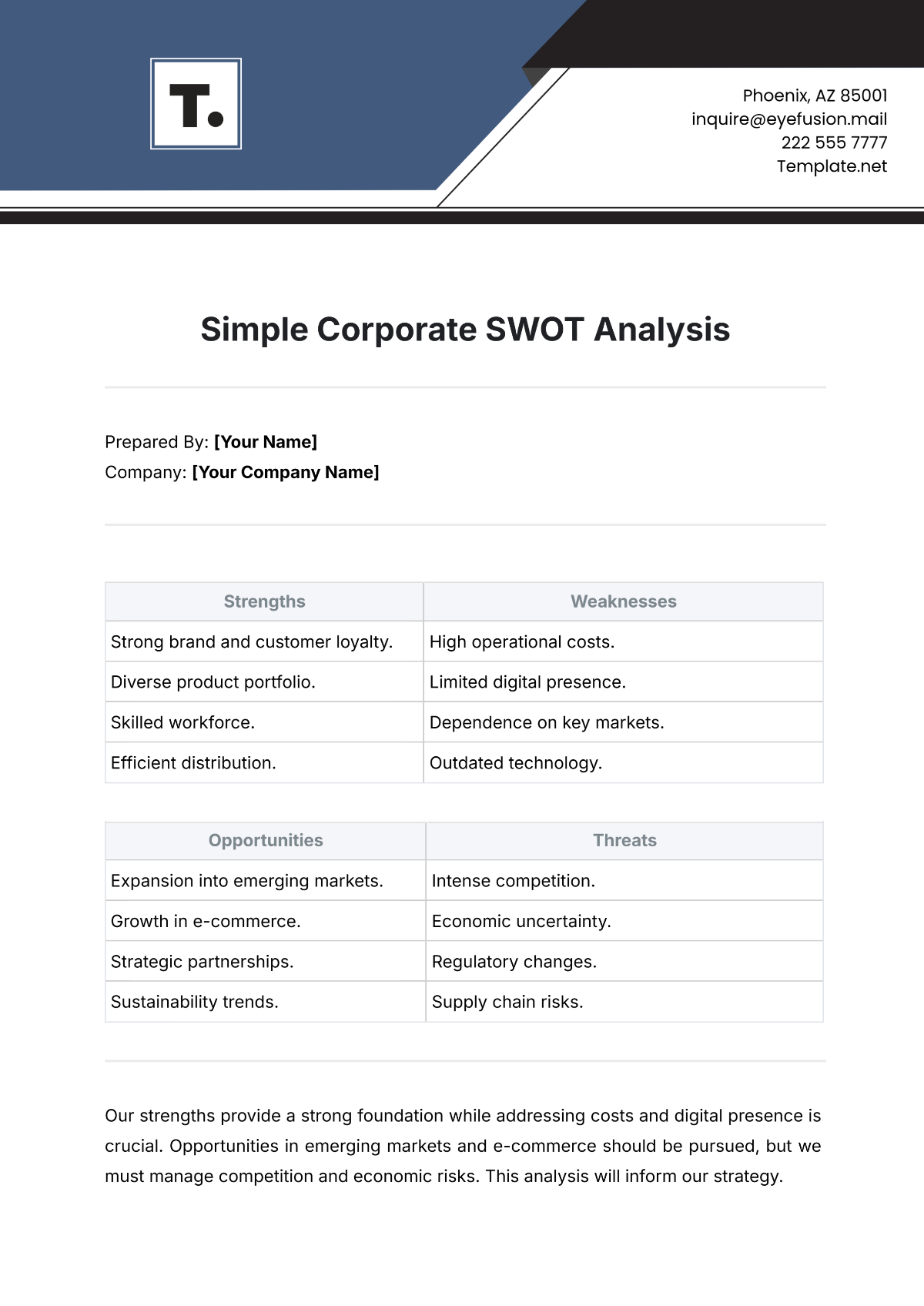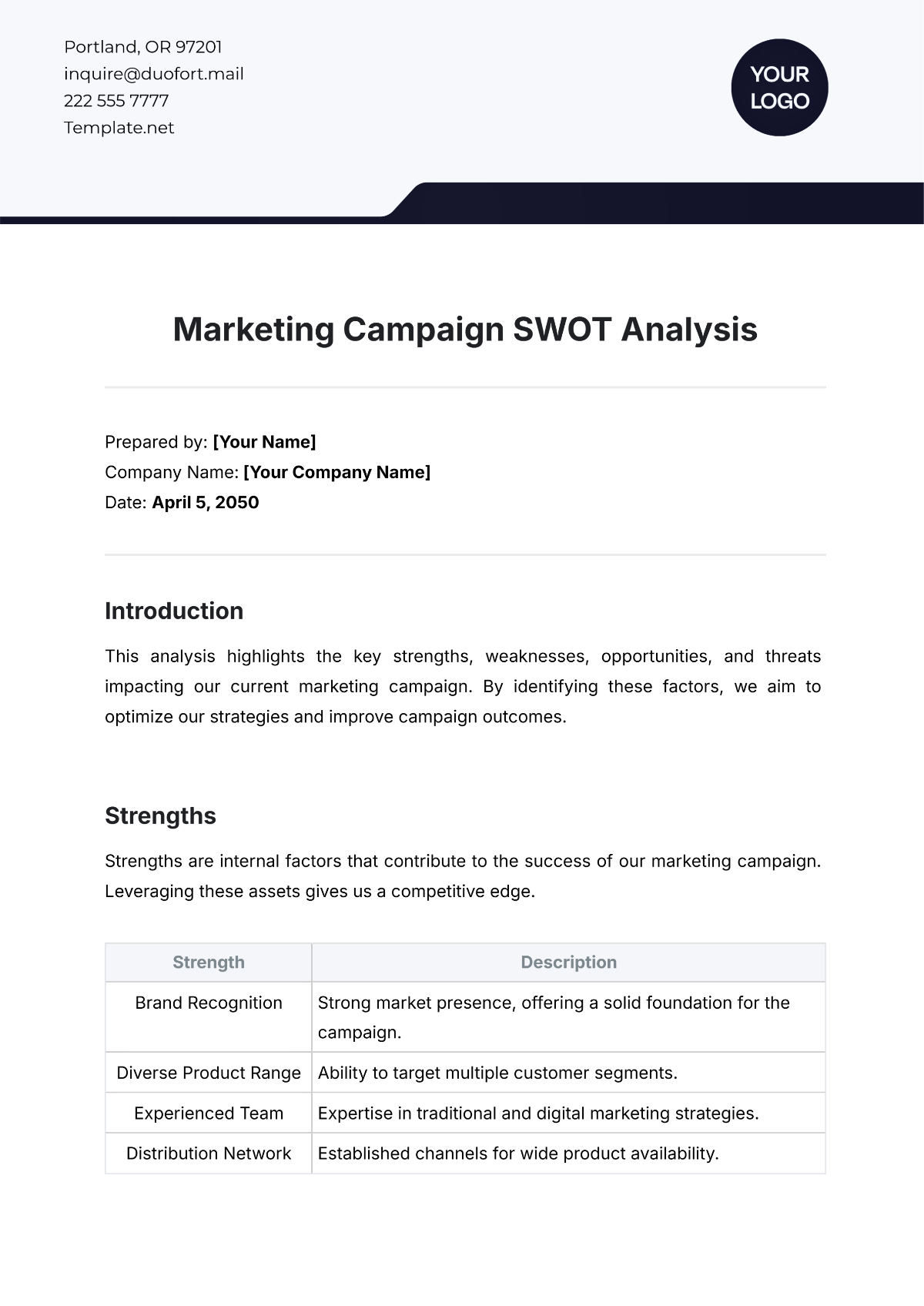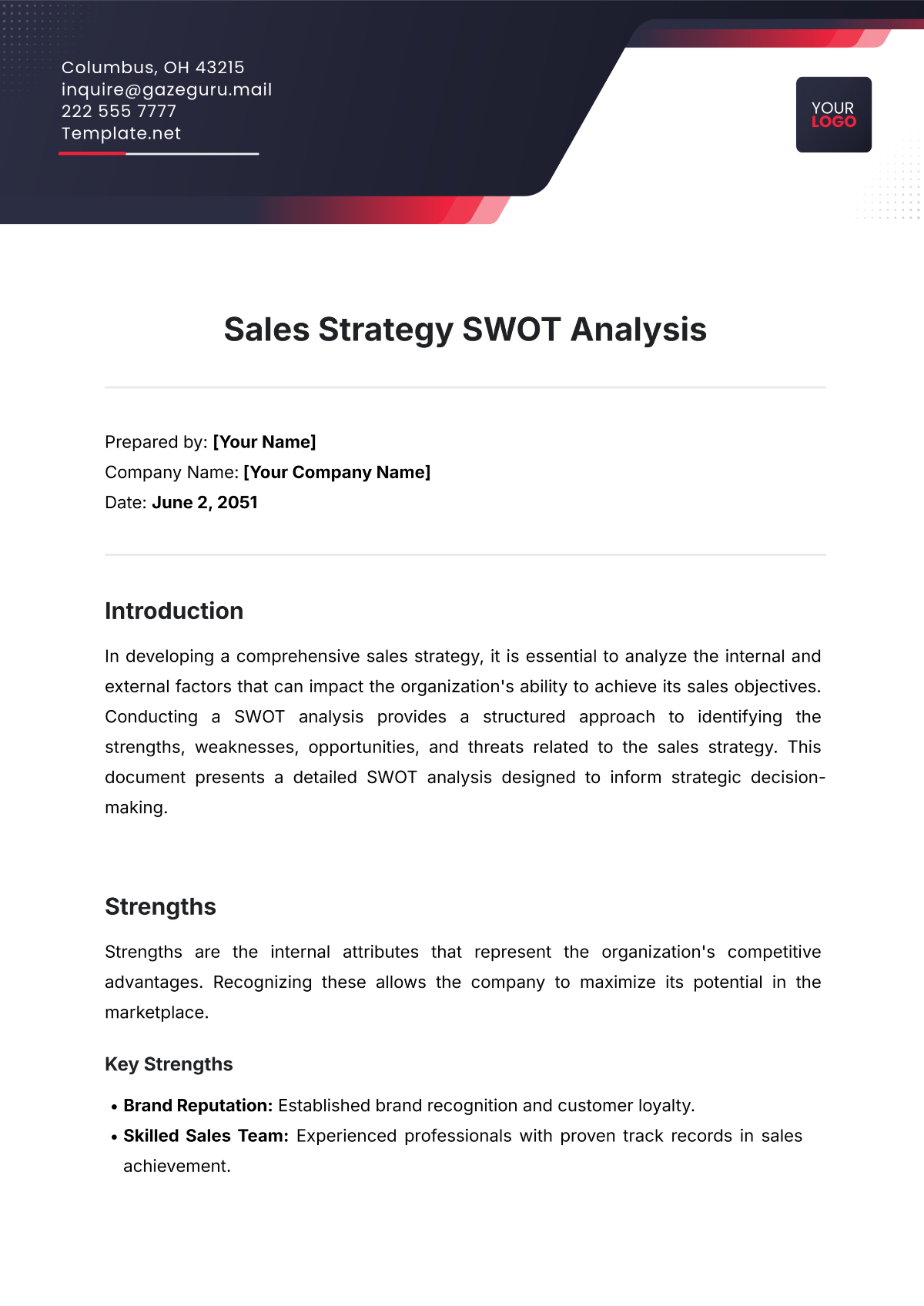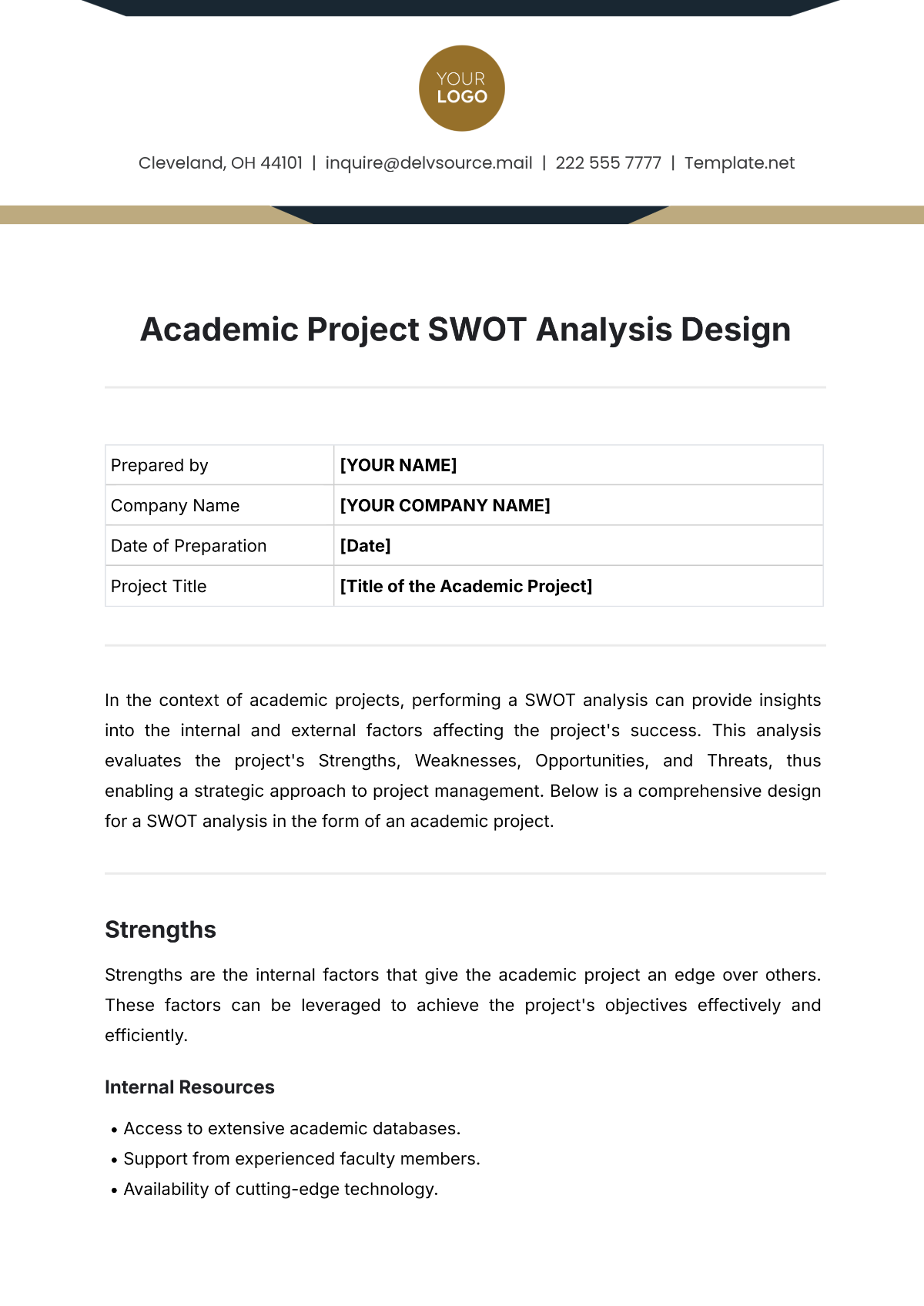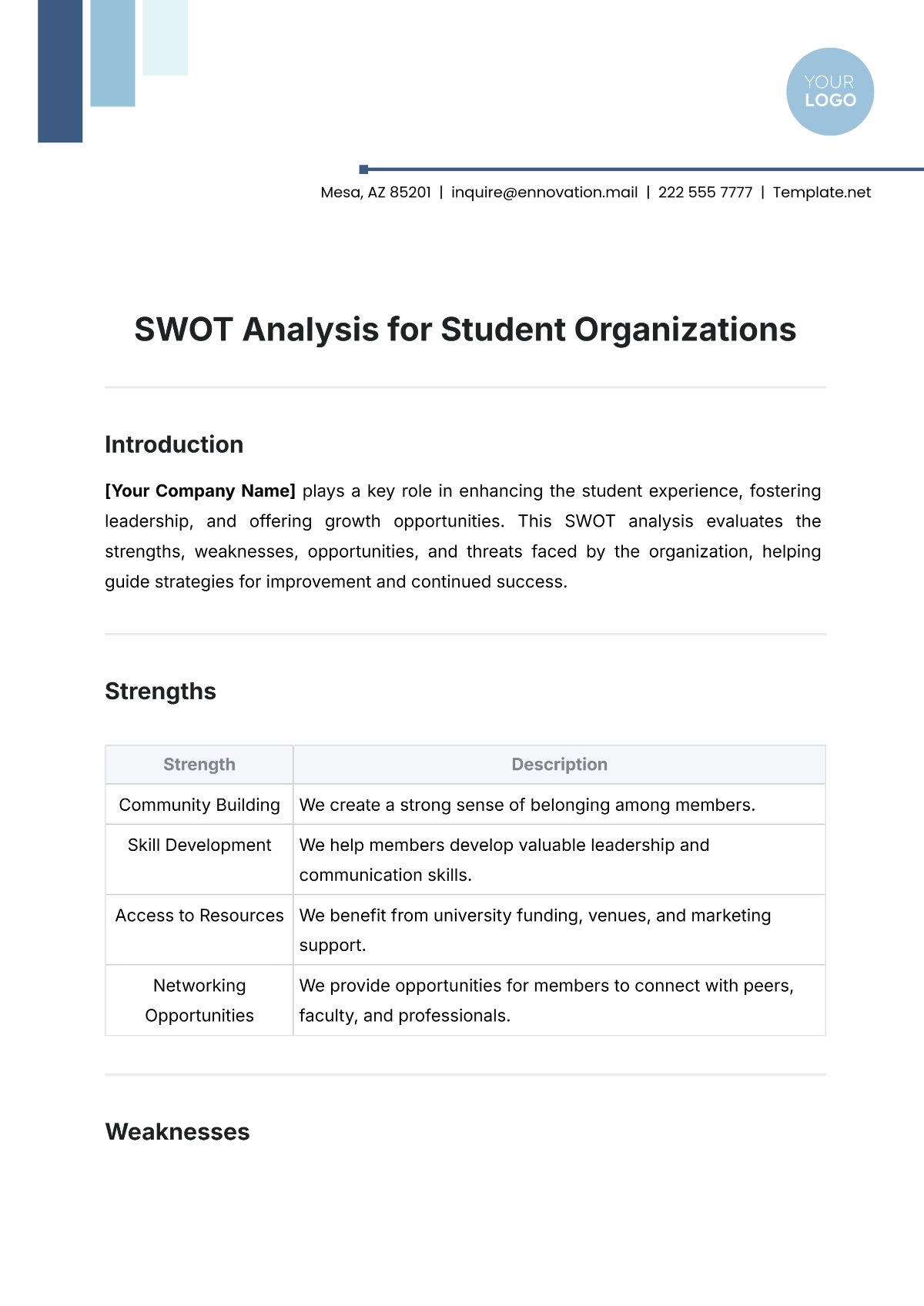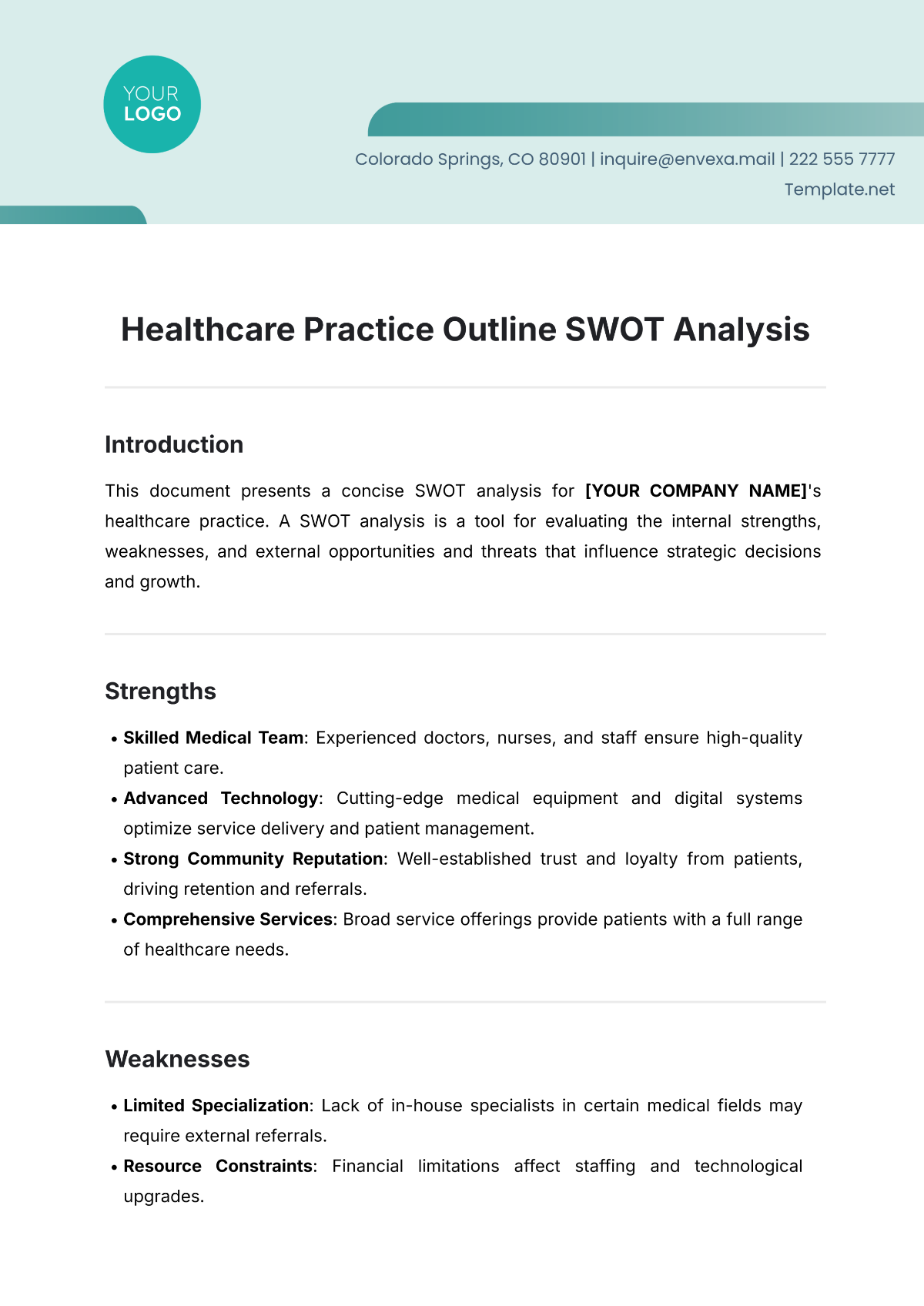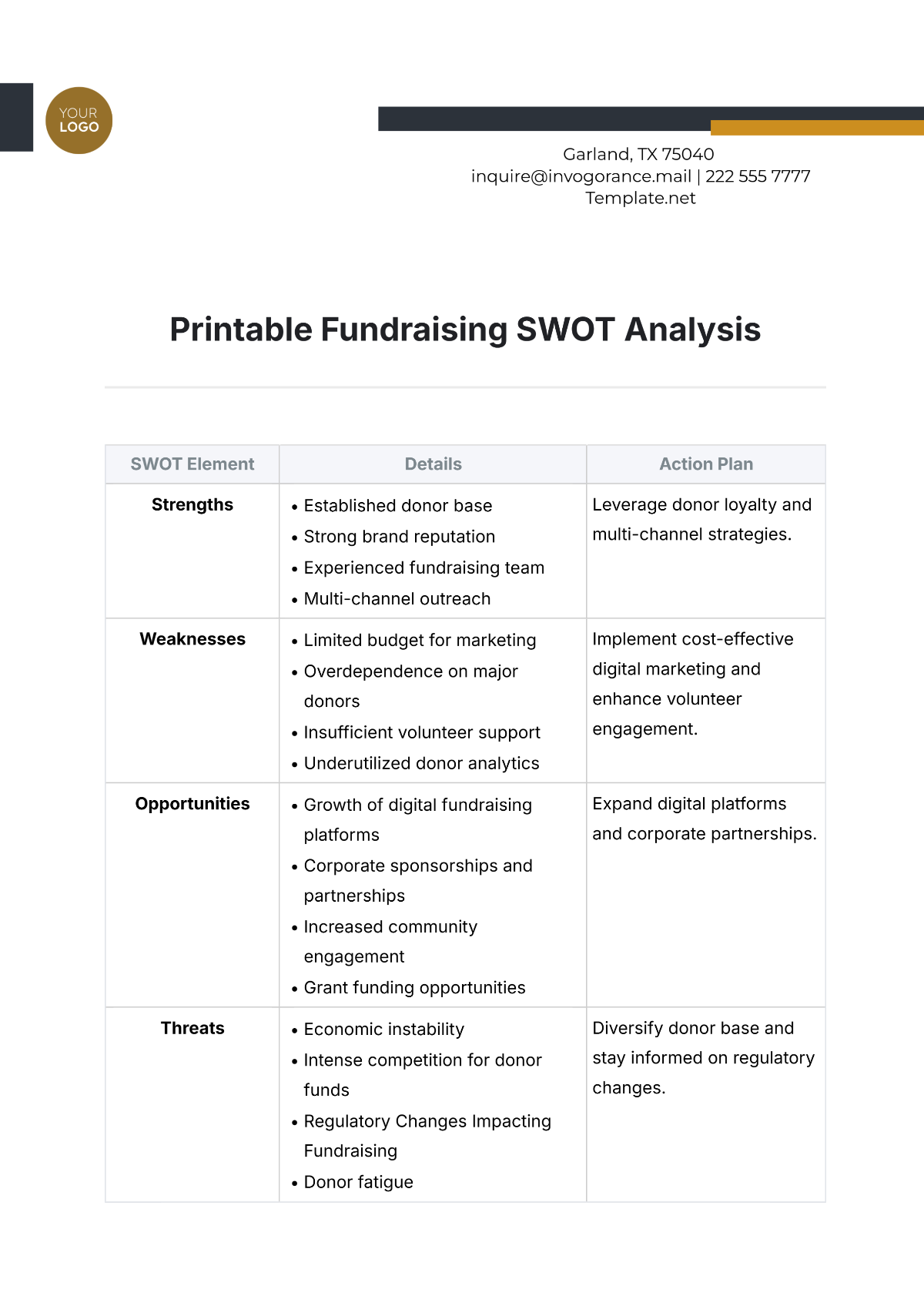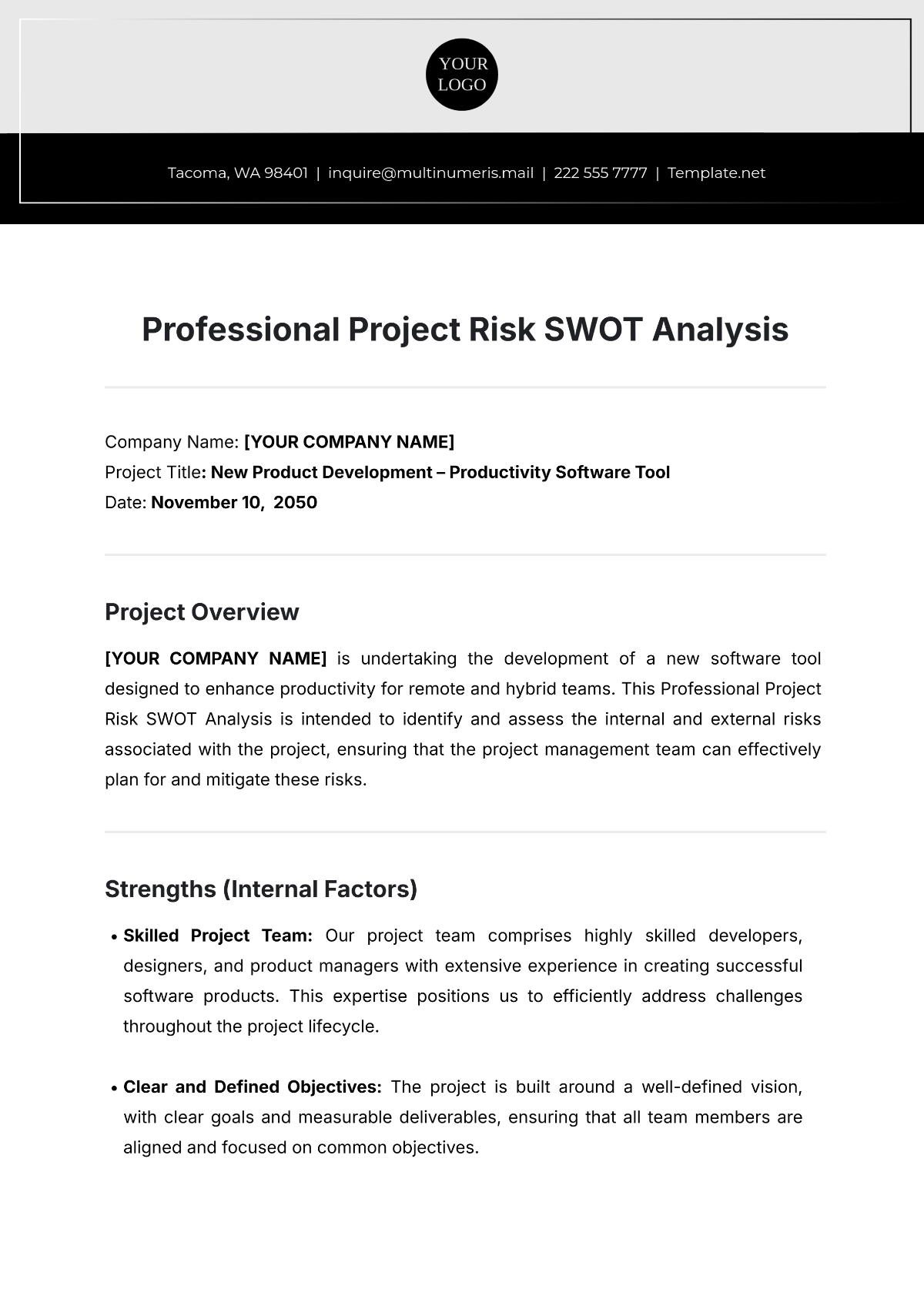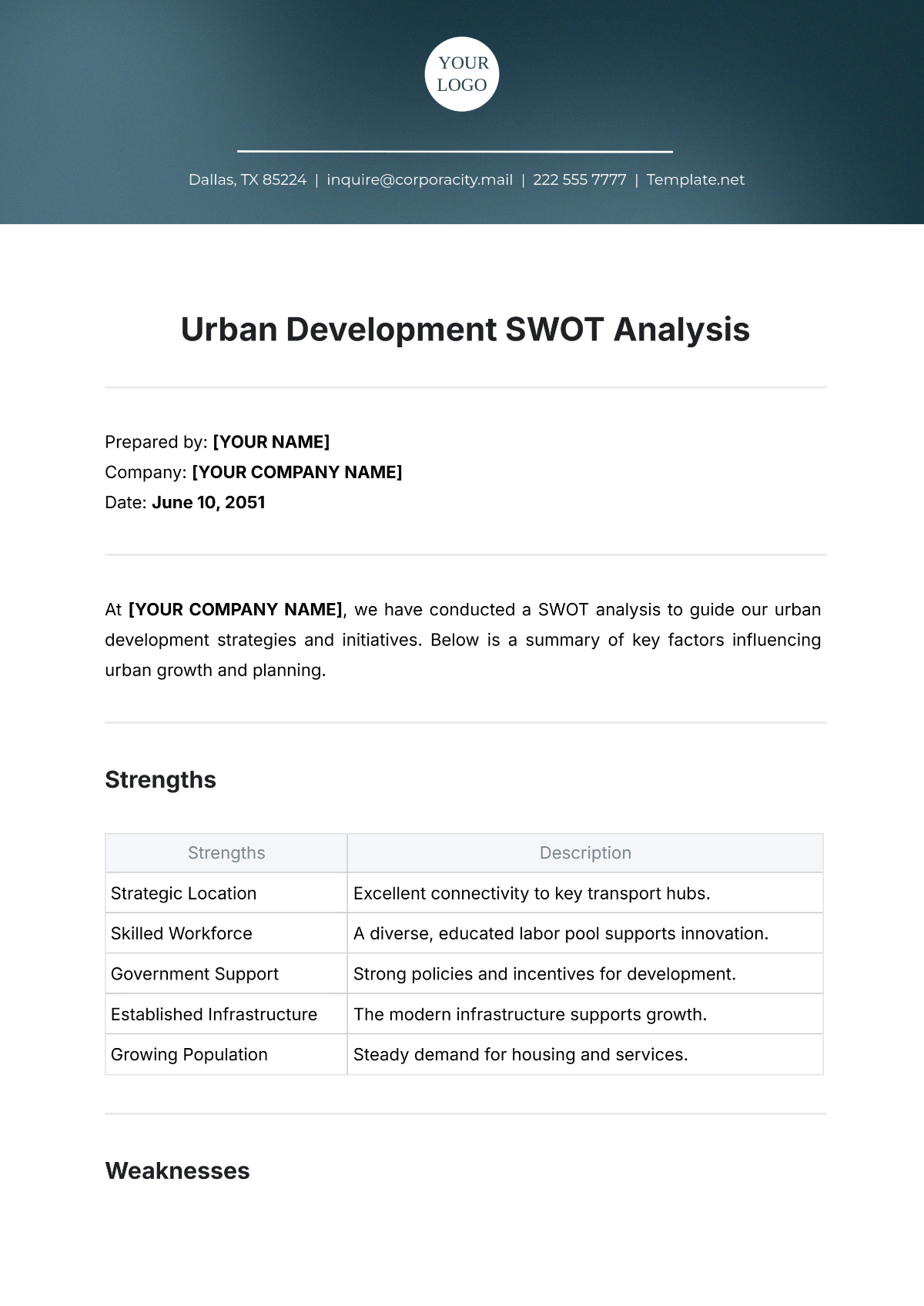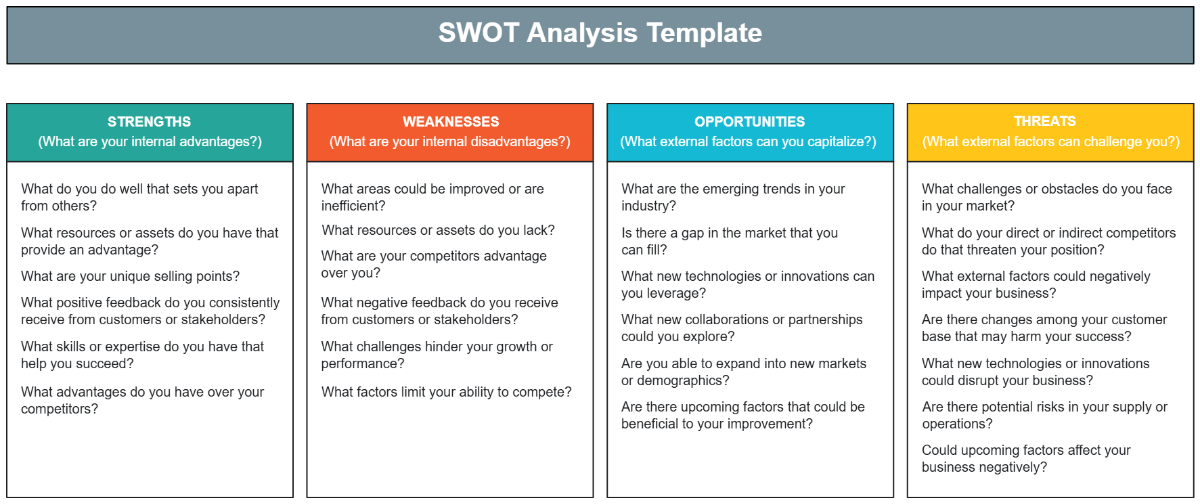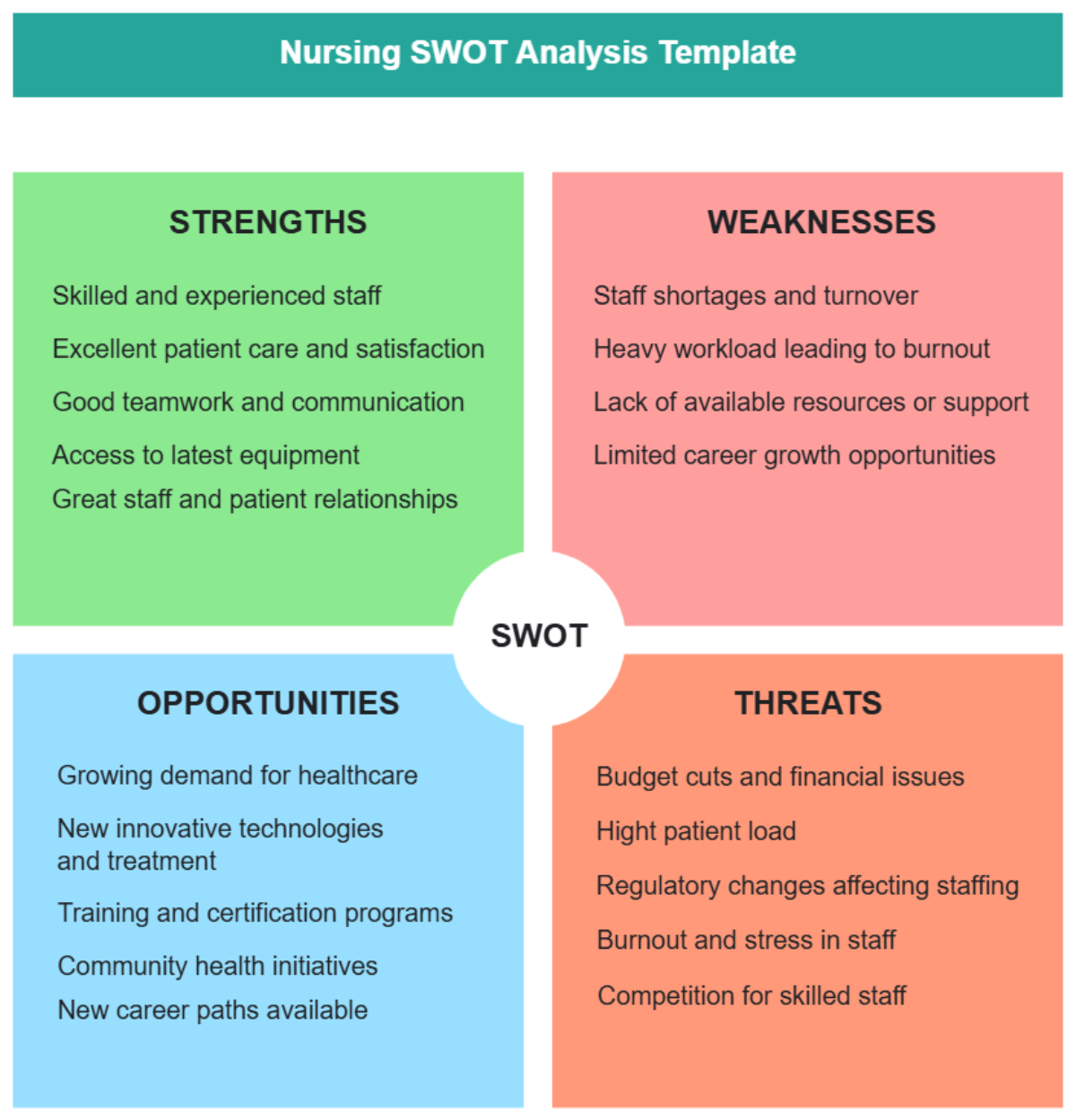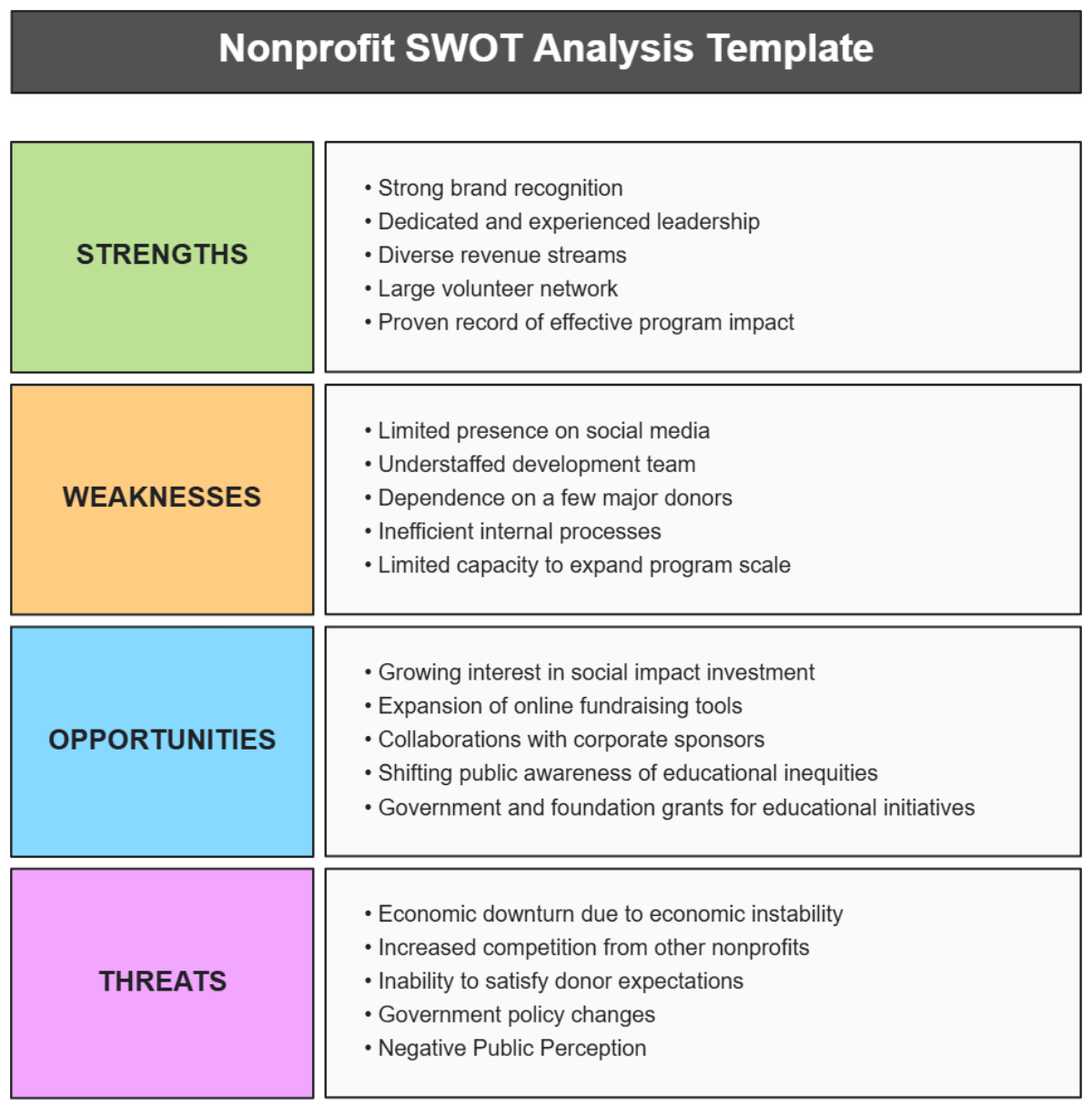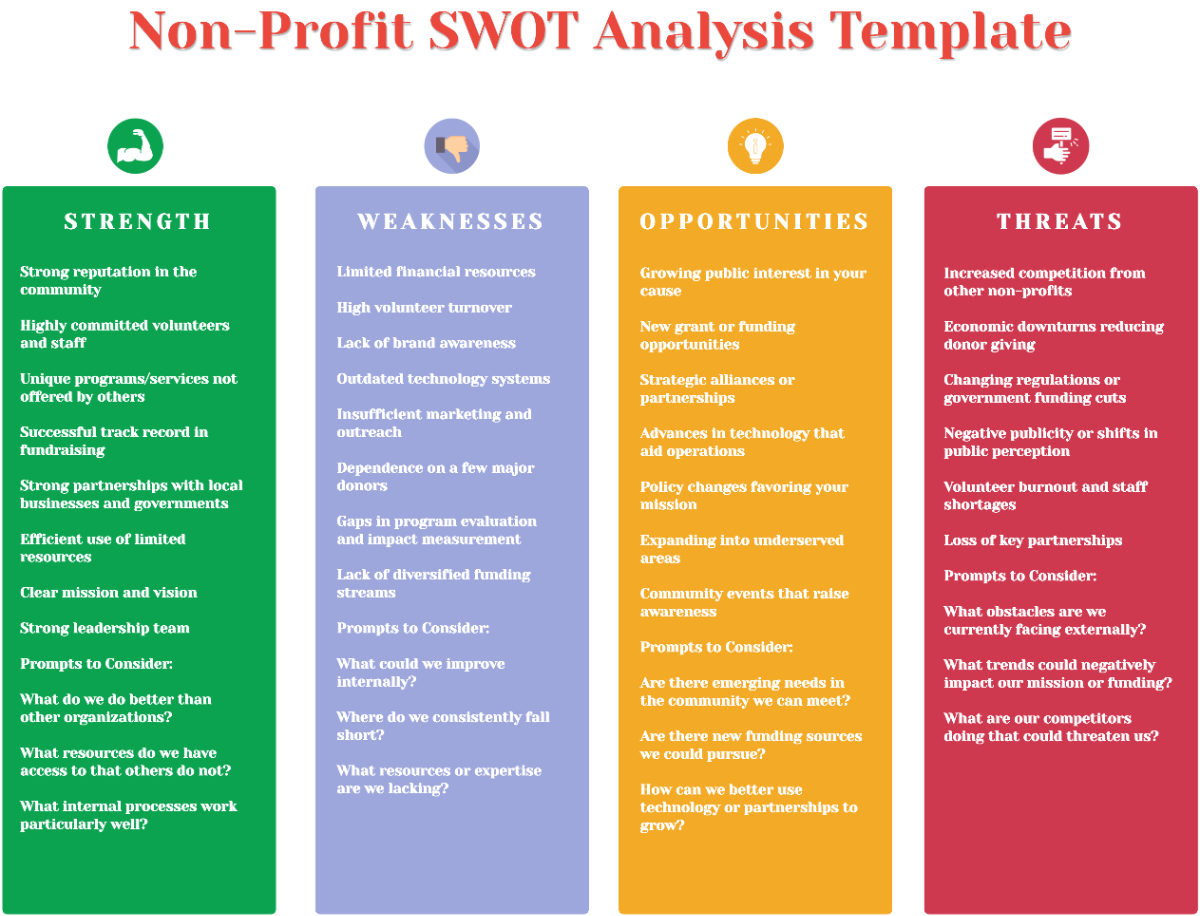Sales SWOT Analysis of Company's Deal Closing Ability
I. Executive Summary
In this Sales SWOT Analysis, we evaluate [Your Company Name]'s deal closing ability, offering a strategic roadmap for improvement. [Your Company Name], operating in a competitive market, has demonstrated several strengths, including an experienced sales team, effective training programs, strong customer relationships, and the use of cutting-edge sales tools. However, several weaknesses, such as inconsistent training, inefficient processes, high turnover, and inadequate follow-up, have been identified.
Opportunities for growth lie in market expansion, product diversification, embracing technological advancements, and forming strategic partnerships. Simultaneously, the company faces threats from fierce competition, economic uncertainties, regulatory changes, and reputation risks.
This analysis serves as a foundation for developing actionable strategies to maximize strengths, address weaknesses, capitalize on opportunities, and mitigate threats, ultimately strengthening [Your Company Name]'s position in the market and enhancing deal closing capabilities.
II. Introduction
In a fiercely competitive market, [Your Company Name] is acutely aware of the critical importance of continuously improving its deal-closing capabilities. This Sales SWOT Analysis is a pivotal step in the company's commitment to assessing and optimizing its sales performance. By shedding light on the strengths, weaknesses, opportunities, and threats in the realm of sales and deal closure, this analysis offers invaluable insights that will guide the formulation of strategic approaches aimed at maintaining a competitive edge in the industry.
III. Strengths
A. Experienced Sales Team
[Your Company Name] prides itself on its seasoned sales force, where the average tenure of each sales professional exceeds a decade. This wealth of experience is a testament to the company's commitment to nurturing and retaining top talent in the industry. The depth of experience not only demonstrates a profound understanding of market dynamics and customer nuances but also instills confidence in clients. This credibility often paves the way for smoother deal closures, as the sales team can expertly navigate complex negotiations, address objections, and build trust.
B. Effective Sales Training
[Your Company Name] recognizes that the sales landscape is dynamic and ever-evolving. To maintain a competitive edge, the company consistently invests in comprehensive sales training programs. These programs go beyond conventional sales techniques and incorporate the latest methodologies and tools. By empowering the sales team with ongoing learning opportunities, the company ensures that its representatives are well-versed in modern selling strategies, including social selling, consultative selling, and data-driven decision-making. Consequently, this leads to higher sales productivity and the ability to adapt swiftly to changing market conditions.
C. Strong Customer Relationships
Building and nurturing long-lasting relationships with clients is not just a strategy but a cultural hallmark of [Your Company Name]. These relationships extend beyond the initial sale, creating a solid foundation for repeat business, referrals, and upselling opportunities. The ability to understand clients' evolving needs and preferences stems from this customer-centric approach, which allows the sales team to identify precisely how the company's solutions align with each client's goals. Such alignment often accelerates deal closures and minimizes sales cycles.
D. Use Of Effective Sales Tools
[Your Company Name]'s commitment to innovation is exemplified by its adoption of cutting-edge sales tools. The implementation of a state-of-the-art Customer Relationship Management (CRM) system and sales automation tools has been transformative. These tools not only streamline the sales process but also provide valuable insights into client behavior, allowing for more precise targeting and personalized interactions. Moreover, data-driven decision-making is enabled, ensuring that sales efforts are directed toward the most promising leads and opportunities. The result is a more efficient and productive sales force, which directly contributes to higher deal closure rates.
IV. Weaknesses
A. Inconsistent Training Programs
While [Your Company Name] invests significantly in sales training, the programs lack standardization and consistency across different sales teams. As a result, there is a discrepancy in the skill levels and knowledge base of the sales force. Some teams may excel in modern sales techniques, while others continue to rely on outdated methods. This inconsistency hampers the company's ability to deliver a uniformly high-quality sales experience to prospects and customers.
B. Outdated Sales Processes
[Your Company Name]'s sales processes, developed in an earlier era, have become outdated and inefficient. These processes are characterized by redundancy, bottlenecks, and manual tasks, resulting in delays in closing deals and a considerable loss of potential opportunities. These inefficiencies not only affect the bottom line but also erode the company's agility in responding to rapidly changing market dynamics.
C. High Turnover And Skill Drain
The company is grappling with a persistently high turnover rate within the sales team. Frequent personnel changes disrupt the continuity of customer relationships and deal-closing efforts. In addition to the logistical challenges of integrating new team members, this high turnover results in a knowledge and skill drain, as experienced sales professionals depart the organization, taking with them valuable insights and relationships that are critical for deal closure.
D. Neglected Follow-Up Practices
[Your Company Name] faces a significant challenge in its follow-up practices. Insufficient follow-up with leads and prospects has become a recurring issue. This inadequate engagement has led to missed opportunities and a substantial decrease in conversion rates. The failure to nurture leads effectively, communicate with prospects, and provide timely and relevant information hinders the company's deal-closing performance, particularly in a market where persistence and personalized engagement are paramount to success.
V. Opportunities
[Your Company Name] has identified several promising opportunities to strengthen its deal closing ability:
A. Market Expansion
The global market is constantly evolving, and [Your Company Name] is well-positioned to capitalize on this by expanding into emerging markets. This strategic move will not only diversify the customer base but also allow the company to tap into new industries and segments, thereby increasing deal-closing potential.
B. Product Diversification
Innovation and diversification of the product line represent a significant opportunity. By introducing new and cutting-edge products, the company can meet the ever-changing demands of customers and respond swiftly to market trends. These new offerings can serve as entry points for upselling and cross-selling, providing additional avenues for closing deals.
C. Technological Advancements
Embracing technological advancements is crucial to staying ahead in the competitive landscape. Leveraging state-of-the-art sales technologies, such as AI-driven analytics and advanced CRM systems, can provide insights into customer behaviors, streamline the sales process, and enable the sales team to engage with prospects more effectively. This enhanced efficiency translates into quicker deal closure and greater conversion rates.
D. Strategic Partnerships
Collaborations with complementary businesses offer a unique chance to create synergy in the market. By forging strategic partnerships, [Your Company Name] can unlock new channels for reaching potential customers. These alliances may not only expand the deal pipeline but also lead to mutually beneficial sales opportunities, where products and services complement each other, resulting in increased deal closure rates.
E. Customer Retention
While the focus is often on acquiring new customers, there is an untapped opportunity in retaining and growing the existing customer base. Implementing a robust customer retention program can lead to increased deal closure rates as satisfied customers are more likely to make repeat purchases and refer others. [Your Company Name] can explore customer loyalty programs, personalized offers, and exceptional post-sales support to seize this opportunity.
F. Evolving Customer Preferences
Market research indicates that customer preferences are shifting towards personalized and experiential interactions. Recognizing this, [Your Company Name] can leverage data analytics and digital platforms to provide tailored solutions, making it easier to connect with customers on a personal level and close deals more effectively.
G. Eco-Friendly Initiatives
With the growing emphasis on sustainability, eco-friendly products and practices are becoming more appealing to customers. [Your Company Name] can explore opportunities to develop and market eco-conscious offerings, tapping into a market segment with a preference for environmentally responsible products, thereby increasing deal-closing potential.
VI. Threats
A. Intense Competition
Threat Level: High
Analysis: The company operates in a market saturated with fierce competitors, each vying for the same pool of potential customers. This intense competition puts significant pressure on deal closing, as prospects have a wide array of choices. Competitors are often well-established and have their own unique value propositions.
Impact: Intense competition can make it challenging to differentiate [Your Company Name]'s offerings and close deals. Prospects may be swayed by competitors' aggressive pricing strategies or alternative solutions.
Recommendations: To address this threat, [Your Company Name] must focus on value differentiation, showcasing its unique selling points, and continuously monitoring and adapting to competitive trends. It may also explore strategic partnerships to broaden its reach and competitive advantage.
B. Economic Uncertainty
Threat Level: Moderate
Analysis: The global economy is subject to fluctuations, and external factors, such as economic downturns, geopolitical events, or unforeseen crisis, can have a significant impact on the purchasing power and confidence of potential customers. Economic uncertainty can lead to hesitancy in decision-making and reduced deal flow.
Impact: Economic instability may result in reduced deal flow, longer sales cycles, and the necessity to offer more attractive terms to close deals. It poses challenges in predicting and planning for future sales revenues.
Recommendations: To mitigate this threat, [Your Company Name] should diversify its customer base across different industries and geographic regions. Maintaining a robust financial buffer and offering flexible payment options to clients during economic downturns can also be beneficial.
C. Regulatory Changes
Threat Level: Low To Moderate
Analysis: The regulatory landscape within the industry is ever-evolving, and companies must adapt to meet new compliance requirements. These changes can affect the sales process by adding complexity and creating additional hurdles in the deal-closing journey.
Impact: Failure to adapt to regulatory changes can lead to legal issues, fines, and disrupted sales efforts. Compliance challenges may also deter potential customers from engaging in business with [Your Company Name].
Recommendations: Staying well-informed about industry regulations, investing in compliance training, and regularly updating sales processes to align with evolving rules and standards are essential steps. [Your Company Name] should also consider employing legal counsel or compliance experts to ensure adherence.
D. Negative Publicity And Reputation Risks
Threat Level: Moderate
Analysis: In the digital age, negative publicity can spread rapidly, impacting a company's reputation. Whether it's due to a product issue, a high-profile customer complaint, or unfavorable media coverage, reputation risks can deter potential customers from engaging with the company.
Impact: Negative publicity can erode trust and confidence in [Your Company Name]'s brand, leading to potential customers seeking alternative solutions. It may also necessitate extensive efforts to rebuild trust, which can be time-consuming and costly.
Recommendations: To manage this threat, [Your Company Name] should invest in proactive reputation management, promptly address customer concerns, and maintain transparency in its communications. Establishing a crisis management plan can help mitigate reputation risks and enable swift damage control in adverse situations.
VII. Analysis Of Key Sales Metrics
In order to gain a quantitative perspective on the company's deal-closing ability, it is essential to analyze key sales metrics that provide insights into the efficiency and effectiveness of the sales processes. The following table summarizes these metrics over the last fiscal year:
Sales Metric | Performance (Last Fiscal Year) | Target For Improvement |
Conversion Rate | 30% | Increase to 35% |
Sales Cycle Duration | 90 days | Reduce to 75 days |
Average Deal Value | $50,000 | Increase to $60,000 |
Win-Loss Ratio | 3:1 | Improve to 4:1 |
Customer Acquisition Cost (CAC) | $2,500 | Reduce to $2,000 |
Customer Retention Rate | 85% | Increase to 90% |
Conversion Rate: The conversion rate reflects the percentage of leads that were successfully converted into paying customers. Although the company achieved a 30% conversion rate in the last fiscal year, the target is to improve this figure to 35% through better lead qualification and more effective sales strategies.
Sales Cycle Duration: The sales cycle duration represents the average time it takes to close a deal from the initial contact. With a current duration of 90 days, the aim is to streamline the process and reduce it to 75 days, enhancing efficiency and accelerating revenue generation.
Average Deal Value: The average deal value measures the average monetary worth of a closed deal. In the last fiscal year, the company secured an average deal value of $50,000, with a target to increase this figure to $60,000 through strategic pricing and upselling techniques.
Win-Loss Ratio: The win-loss ratio compares the number of deals won to the number of deals lost. Currently standing at 3:1, the company seeks to improve this ratio to 4:1 by addressing weaknesses in the sales process and refining the value proposition.
Customer Acquisition Cost (CAC): The customer acquisition cost indicates how much the company spends to acquire a new customer. Although the CAC is at $2,500, the objective is to reduce it to $2,000 by optimizing marketing efforts and lead generation channels.
Customer Retention Rate: The customer retention rate measures the percentage of customers who continue to do business with the company over a specified period. With an 85% retention rate, the goal is to increase it to 90% through enhanced customer support and post-sales engagement strategies.
VIII. Strategies For Improvement
The Sales SWOT Analysis has identified several key areas where [Your Company Name] can enhance its deal closing ability. To address these findings, the following strategies are recommended:
Area For Improvement | Strategies For Enhancement |
Lack of Training | Implement a standardized and ongoing training program for all sales teams. Ensure that all team members have access to the same training resources and opportunities for skill development. |
Inefficient Sales Processes | Conduct a thorough review of the current sales processes, identifying bottlenecks and areas of inefficiency. Streamline and automate where possible, reducing the sales cycle duration. |
High Turnover | Focus on improving employee retention by enhancing the work environment and offering incentives for long-term commitment. - Develop a mentorship program to facilitate knowledge transfer from experienced team members to new recruits. |
Inadequate Follow-Up | Implement a lead nurturing system that includes timely and personalized follow-ups to engage prospects effectively. - Utilize CRM and marketing automation tools to automate follow-up tasks and maintain regular contact with leads. |
IX. Conclusion
In conclusion, the Sales SWOT Analysis of [Your Company Name]'s deal closing ability highlights the company's strengths, weaknesses, opportunities, and threats in the realm of sales and deal closure. This comprehensive evaluation reveals a clear path forward for improving the sales function and, ultimately, driving revenue growth. By capitalizing on strengths, addressing weaknesses, seizing opportunities, and mitigating threats, [Your Company Name] is poised to elevate its position in the market, outperform competitors, and secure a brighter future for the organization.
X. Recommendations
Based on the findings of this analysis, the following key recommendations are proposed:
Standardized Sales Training: Implement a standardized and comprehensive sales training program for all teams to ensure consistency and enhance the skills of the entire sales force. Regular training updates should be prioritized to keep the team aligned with the latest industry trends.
Streamlined Sales Processes: Revise and modernize inefficient sales processes to reduce deal-closing cycle times and minimize lost opportunities. Automation and digitization should be explored to enhance process efficiency.
Employee Retention Strategies: Develop strategies to reduce turnover within the sales team, such as improving compensation packages, providing growth opportunities, and fostering a positive work environment. A stable and experienced sales force is key to building lasting customer relationships.
Enhanced Lead Follow-Up: Implement a robust lead management system to ensure prompt and consistent follow-up with leads and prospects. A structured approach to nurturing leads will lead to higher conversion rates.
Market Expansion And Product Innovation: Capitalize on market expansion opportunities by entering new segments and geographical areas. Additionally, invest in research and development to introduce innovative products or services that address evolving customer needs and trends.
Technology Integration: Embrace the latest sales technologies, including artificial intelligence, data analytics, and customer relationship management systems, to gain deeper insights into customer behavior, improve sales forecasting, and personalize the sales approach.
Regulatory Compliance: Stay vigilant and proactive in monitoring and adapting to changes in regulatory environments. Regular compliance training and the creation of a dedicated compliance team can help mitigate legal risks.
Reputation Management: Develop and maintain a robust reputation management strategy to mitigate the impact of negative publicity. Proactive communication and brand enhancement efforts can help maintain a positive image.
These recommendations should be integrated into a comprehensive action plan with clear timelines and performance indicators. Regular monitoring and adjustments to the strategies are essential to achieving sustained improvements in deal-closing ability.
